Athletes regularly test the limits of their bodies, whether they’re playing a team sport or exercising solo. One of the most important aspects of physical fitness, however, happens when they’re largely immobile: sleep.
An active lifestyle must be balanced by an investment in rest. And because athletes are often specialists in their sport of choice, their mattresses should be specialized as well. A muscular weightlifter may not need the same features in a bed as a long-distance runner, for example.
In collecting this list of the best mattresses for athletes, I focused on beds that encourage comfort after a vigorous workout, but I also wanted to acknowledge that the word “athlete” contains multitudes. I selected mattresses that cater to a range of sports and exercise modalities, in hopes that you’ll find the right match for your nightly cool-down.
What’s the Best Mattress for Athletes?
The Helix Midnight Luxe is a phenomenal bed for athletic folks. It earned high marks during testing for its pressure- and pain-relieving abilities, as well as its cooling elements. Its coil unit also has a dedicated lumbar zone for targeted lower-back support.
Best Mattress for Athletes
- Helix Midnight Luxe – Editor’s Pick
- Nectar – Best Mattress for Athletes with Shoulder Pain
- Bear Elite Hybrid– Best Mattress for Weightlifters
- DreamCloud – Best Mattress for Runners
- WinkBed Plus – Best Mattress for Plus-Size Athletes
- Nolah Evolution – Best Cooling Mattress for Athletes
- Brooklyn Bedding Spartan – Best Mattress for Muscle Recovery
- Saatva Classic – Best Mattress for Athletes with Back Pain
- Bear Original – Best Firm Mattress for Athletes
Compare the Best Mattresses for Athletes
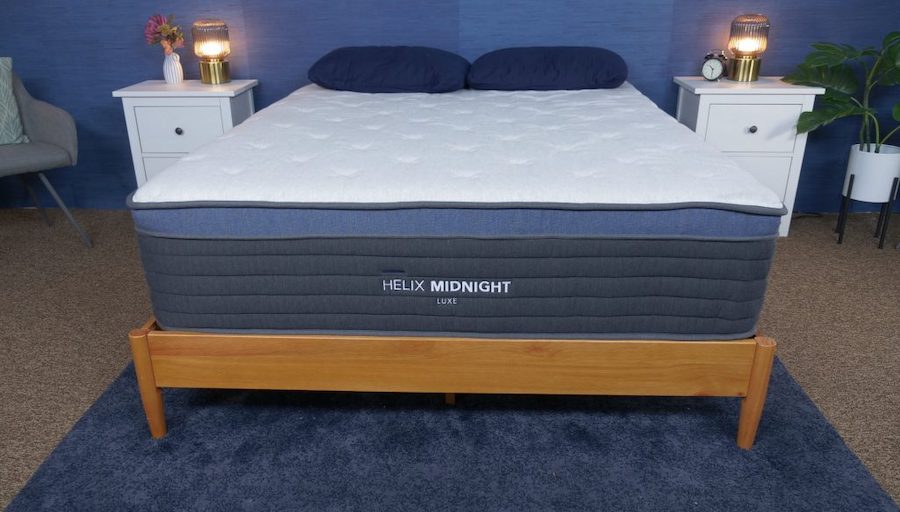
|
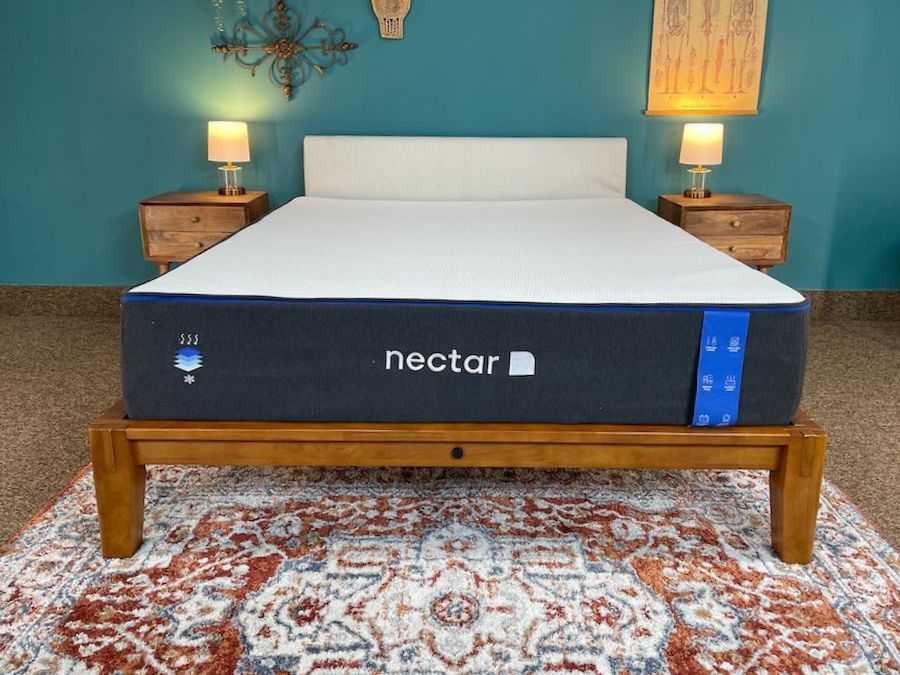
|
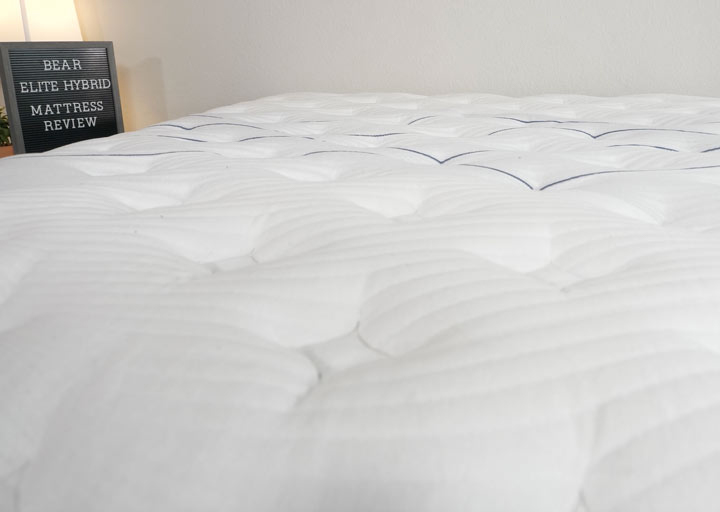
|
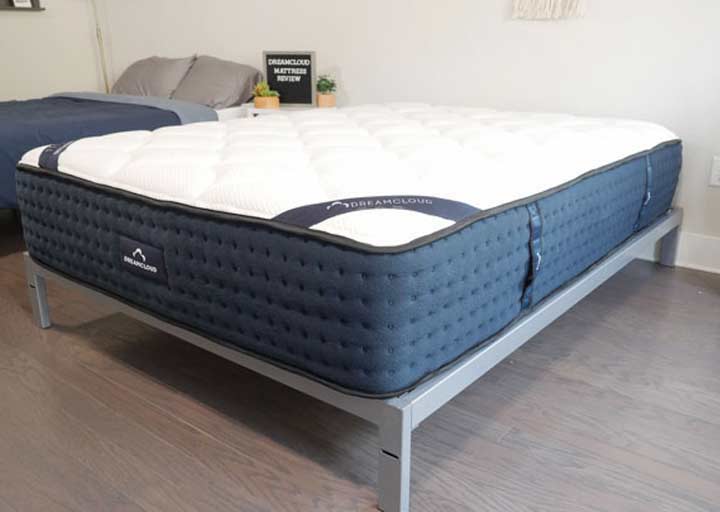
|
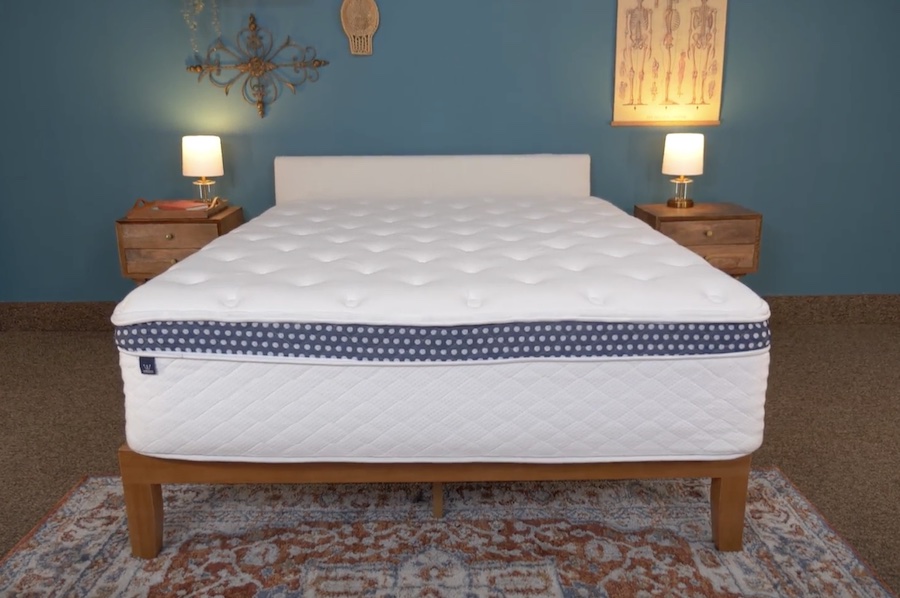
|
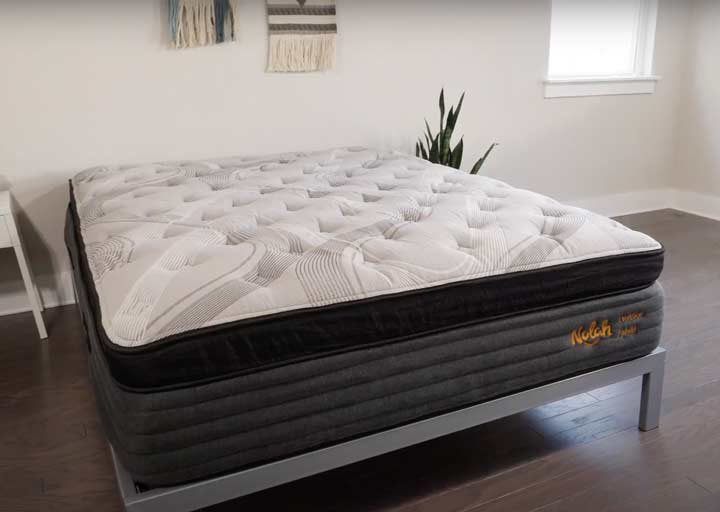
|
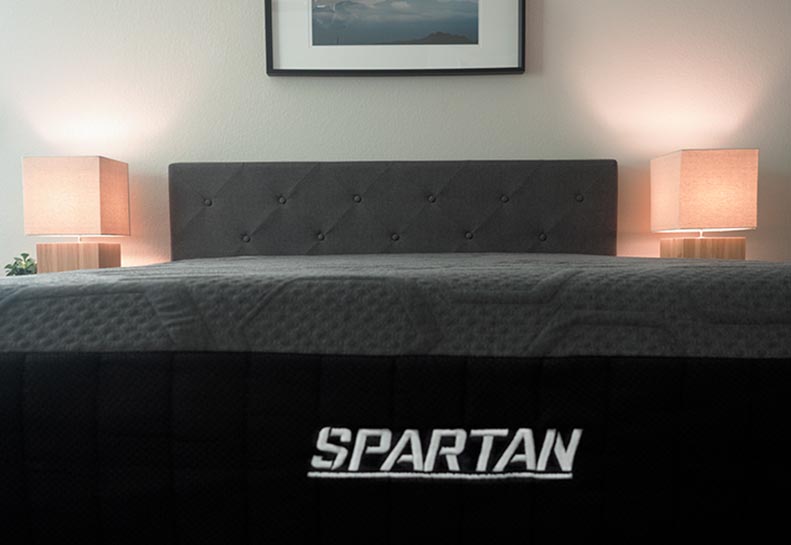
|
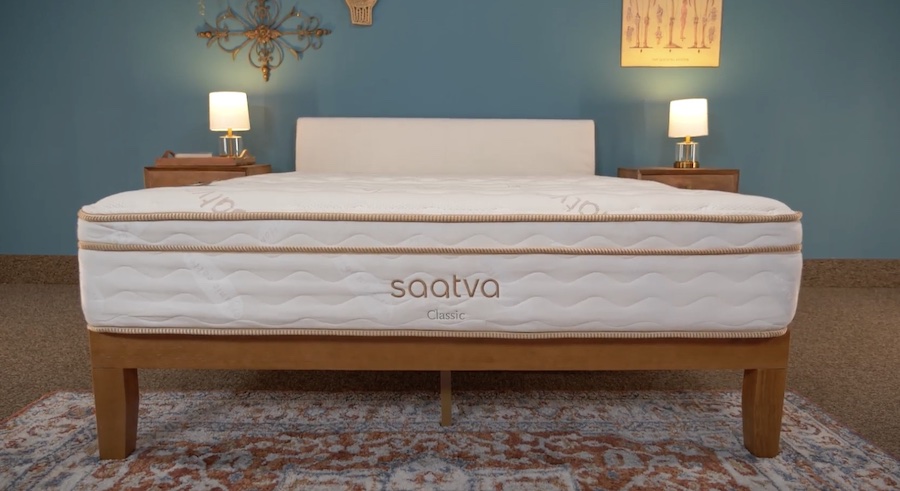
|
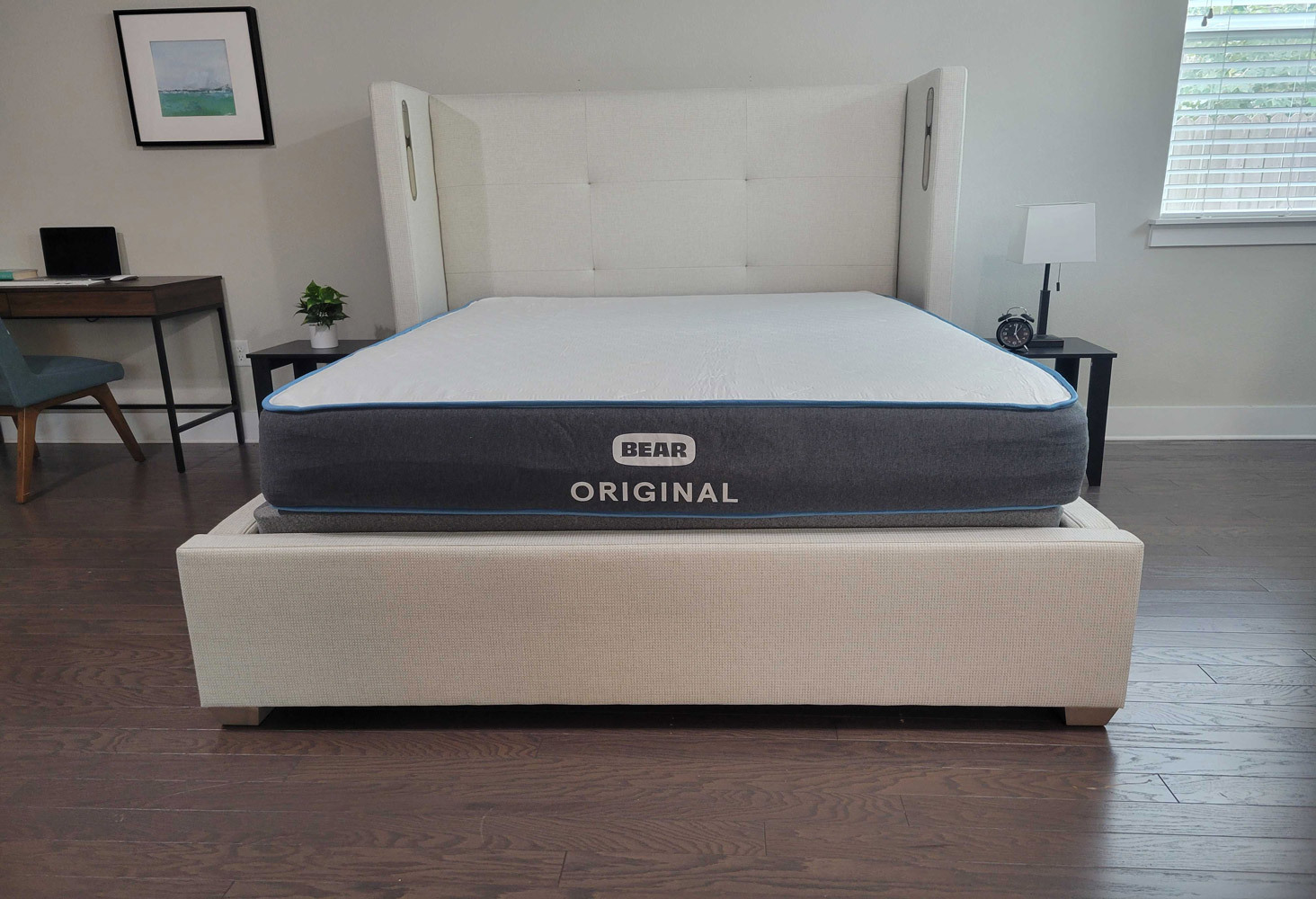
|
|
| Helix Midnight Luxe Mattress | Nectar Mattress | Bear Elite Hybrid Mattress | DreamCloud Original Mattress | WinkBed Plus Mattress | Nolah Evolution Hybrid Mattress | Brooklyn Bedding Spartan Hybrid Mattress | Saatva Mattress | Bear Original Mattress | |
| Rating | |||||||||
| Firmness | Medium-firm: 6/10 | Medium-firm: 6.5/10 | Medium-firm: 6/10 | Medium-firm: 6.5/10 | Medium-firm: 6.5/10 | Multiple firmness options | Multiple firmness options | Multiple firmness options | Medium-firm: 6.5/10 |
| Material | Hybrid | Foam | Hybrid | Hybrid | Hybrid | Hybrid | Hybrid | Innerspring | Foam |
| Cooling | — | — |
|
|
|
— | — |
|
|
| Warranty | 15-year warranty | Lifetime warranty | Lifetime Warranty | Lifetime warranty | Lifetime warranty | Lifetime warranty | 10-year warranty | Lifetime warranty | Lifetime warranty |
| Shipping | Free shipping | Free shipping | Free shipping | Free shipping | Free shipping | Free shipping | Free shipping | Free white glove delivery | Free shipping |
| Trial Period | 100 nights | 365 nights | 120 nights | 365 nights | 120 nights | 120 nights | 120 nights | 365 nights | 120 nights |
| Best For | Back Sleepers, Stomach Sleepers, Side Sleepers | Back Sleepers, Side Sleepers, Hip Pain, Joint Pain | Back Sleepers, Stomach Sleepers, Hot Sleepers | Back Sleepers, Hot Sleepers, Seniors | Back Sleepers, Stomach Sleepers, Hot Sleepers | Side Sleepers, Back Sleepers | Joint Pain, Back Pain, Side Sleepers | Back Sleepers, Stomach Sleepers, Back Pain, Hot Sleepers | Hot Sleepers, Back Sleepers, Side Sleepers |
How We Chose the Best Mattress for Athletes
At Sleep Advisor, we physically bring mattresses into our studio and put them through a battery of in-person tests. Generally, we want to know how well they perform in categories such as edge support, pressure relief, and cooling. We also have multiple people lie on top of each bed so that we can know how they feel to different body types.
For this list, we paid the most attention to factors that are relevant to athletes who want to recuperate well at night. We tried to find beds that matched well with a mix of scenarios and sports, including ones that cradled commonly injured areas.
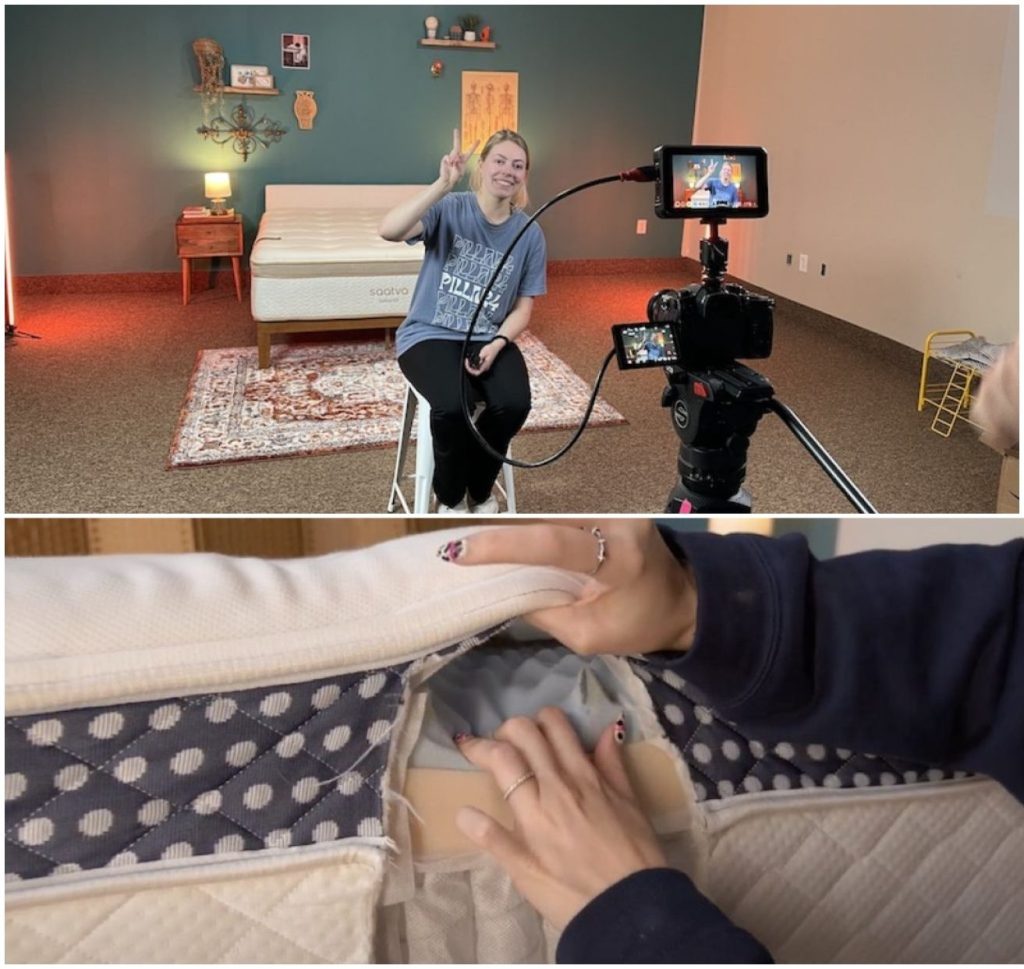
We also consulted several experts to help us get an idea of what athletes need from their beds. We spoke to Caine Wilkes, a former Olympian and competitive weightlifter; Andrew Cusmano, a Bowerman Track Club Elite Athlete; and a high school athlete, Henry Russell, who plays football, wrestles, and lifts weights regularly.
Advice from Accomplished Athletes
“I sleep pretty evenly between my back and side, so I prefer [a bed] that’ll provide overall support on my back, hips, or shoulders. I prefer a firm mattress because I want that support, especially because I’m a bigger athlete; I’ll sink a little too much on anything softer.”
— Caine Wilkes, Competitor in the 2020 Summer Olympics and 3-time Gold Medalist in the Pan American Weightlifting Championships
“The [firmer] the better, as long as I have a good pillow to accompany it … Softer causes back problems.”
— Andrew Cusmano, Bowerman Track Club Elite Athlete
“Eight hours of quality sleep is needed for me to perform at my best. As a side sleeper, I need a mattress that provides pressure relief for my hips and shoulders but is also firm enough to provide spinal alignment.”
— Henry Russell, High School Athlete
What We Want to See in a Mattress for Athletes
Based on feedback from athletes themselves and our extensive knowledge of the mattress marketplace, we looked for the following traits in the mattresses we chose for this roundup:
Support Over Softness
Athletes need stable support and spinal alignment from their beds, lest they experience back pain in addition to the soreness from training. A sturdy innerspring unit or base foam should provide this bracing foundation, while comfort foams up top help with pressure relief.
Decent Cooling
No one wants to feel overheated at night, and athletes can run even hotter than the average person. A mattress with effective cooling components helps to stave off sweating and restlessness.
Enhancements that Target Sore Muscles
Some of the beds on the list below feature special textiles (e.g. Celliant®) that claim to promote muscle recovery via infrared energy. These technologies may add a nightly boost to your athletic routine (though we should add the caveat that research on their efficacy is sparse).
Best Mattress for Athletes
Helix Midnight Luxe – Editor’s Pick
Helix Midnight Luxe Mattress
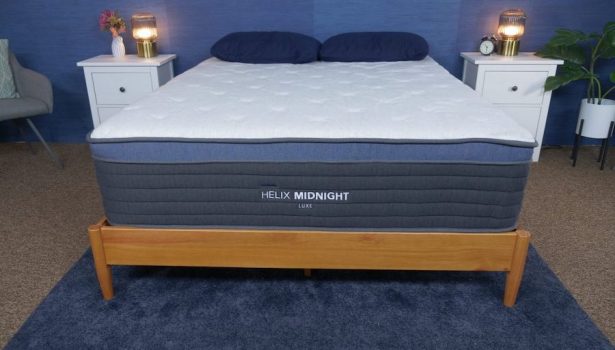
With the Ultra-Cool phase-changing cover and gel-infused foam, the Helix Midnight Luxe is an excellent choice for hot sleepers who also need pressure relief and zoned support.
Material
Hybrid
Trial Period
100 nights
Shipping Method
Free shipping
Firmness
Medium-firm: 6/10
Warranty
15-year warranty
Price Range
$$$$$
We recommend this mattress for the following sleeper types:
Back Sleeping
Ideal for average weight and heavyweight back sleepers.Side Sleeping
Ideal for average weight and heavyweight side sleepers.Stomach Sleeping
Ideal for lightweight stomach sleepers.Financing Options
Financing options are available for this mattress.
Helix Midnight Luxe Mattress

With the Ultra-Cool phase-changing cover and gel-infused foam, the Helix Midnight Luxe is an excellent choice for hot sleepers who also need pressure relief and zoned support.
Material
Hybrid
Warranty
15-year warranty
Firmness
Medium-firm: 6/10
Shipping Method
Free shipping
Trial Period
100 nights
Price Range
$$$$$
We recommend this mattress for the following sleeper types:
Back Sleeping
Ideal for average weight and heavyweight back sleepers.Side Sleeping
Ideal for average weight and heavyweight side sleepers.Stomach Sleeping
Ideal for lightweight stomach sleepers.Financing Options
Financing options are available for this mattress.

Helix Midnight Luxe Mattress
With the Ultra-Cool phase-changing cover and gel-infused foam, the Helix Midnight Luxe is an excellent choice for hot sleepers who also need pressure relief and zoned support.
Material
Hybrid
Firmness
Medium-firm: 6/10
Trial Period
100 nights
Warranty
15-year warranty
Shipping Method
Free shipping
Price Range
$$$$$
We recommend this mattress for the following sleeper types:
Back Sleeping
Ideal for average weight and heavyweight back sleepers.Side Sleeping
Ideal for average weight and heavyweight side sleepers.Stomach Sleeping
Ideal for lightweight stomach sleepers.Financing Options
Financing options are available for this mattress.
Why the Helix Midnight Luxe Earned Best Mattress for Athletes Overall
The word “athlete” covers a wide range of sports and specialists. To decide on a bed that could satisfy a large slice of the active world, I thought about mattresses that have a versatile feel, features that can help with pain relief, and a structure that suits most body types. The Helix Midnight Luxe quickly rose to the top of the pack.
This luxury bed is right in the sweet spot at a 6 out 10 on our firmness scale. It’s a medium-level firmness that feels good to most folks—and it’s especially soothing when you’re relaxing on the Midnight Luxe’s pillow top. During testing, I was also impressed by the lumbar support I received from this bed’s zoned coil unit. I tested its capacity for pressure relief by using a color-coded pressure map, and was pleased to see that it cushioned my body evenly, with no regions lighting up as problem zones.
Finally, whether you’re a willowy or heavyweight athlete, the Helix Midnight Luxe can most likely meet your needs. The only athletes I’d steer away from this bed are those who sleep exclusively on their stomach and weigh more than 250 pounds. If that’s you, you’ll need a bit more lift for your hips than this bed can provide.
What’s the Helix Midnight Luxe Made Of?
The Helix Midnight Luxe is 13.5 inches tall and has six key layers.
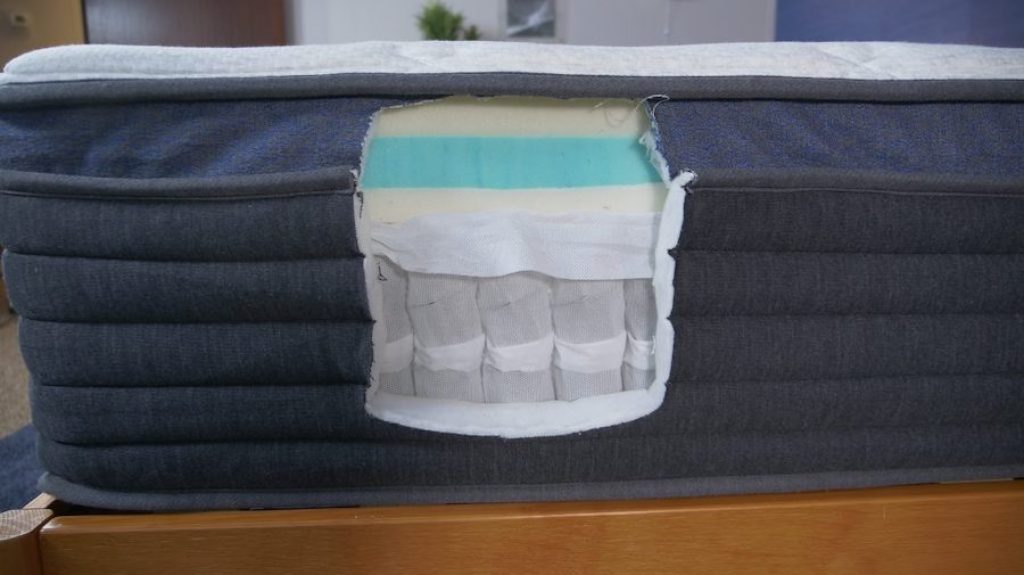
- Layer 1 – Cooling Pillow Top. Quilted with an inch of foam for immediate comfort, this pillow top has a Tencel™ cover that breathes well and wicks away moisture. If you’re worried about overheating, you can upgrade to a GlacioTex™ Cooling Cover for an extra fee.
- Layer 2 – Helix Responsive Foam. A fast-acting foam that cushions your body but reforms quickly when you move around on top of it.
- Layer 3 – Copper Gel Memory Foam. This layer molds to the shape of your silhouette and guards against heat buildup with the cooling properties of gel and copper. The copper also conveys antimicrobial benefits.
- Layer 4 – Memory Plus Foam. A dense, proprietary memory foam developed by Helix for underlying support.
- Layer 5 – Zoned Coils. These springs are individually wrapped and zoned to provide sturdier support beneath the hips and lumbar region. They’re also reinforced along the sides of the bed so the edges hold strong.
- Layer 6 – DuraDense Foam. A thick, stabilizing foam base.
My Take: This truly is a meaningful improvement over its predecessor, the Helix Midnight. The addition of full-perimeter edge support, a palpable boost beneath the lumbar area, and a swanky pillow top earned it high marks across the board from me, including in category of pain relief—an important consideration for athletes who experience regular soreness.
What I Liked
- Edge support stands out – Athletes shouldn’t discount the importance of strong edges. They make getting in and out of bed easier, especially if your mobility is compromised (however temporarily). If you have a large wingspan or tend to spread out during the night, good edge support will also leave you feeling secure rather than unstable near the sides of the mattress. The Helix Midnight Luxe got a solid 4 out 5 in this category.
- Cool and cozy – The Midnight Luxe should stay quite cool during the night. Whether or not you opt for the upgraded cooling cover, the airflow around its springs and the gel-infused foam layer should both keep the temperature well-controlled.
Potential Drawbacks
- Doesn’t contain motion – My biggest complaint about the Helix Midnight Luxe is that it doesn’t isolate motion supremely well. Its springs and foams prioritize responsiveness so that you can move around in the bed easily, but as a consequence, you can feel a sleeping partner’s movements.
- Too soft for stomach sleeping – If you’re a heavy stomach sleeper, you may want a firmer mattress than this one. Even with the extra lift in the lumbar area, your hips are apt to dip too low and take your spine out of its natural alignment.
Customer Reviews of the Helix Midnight Luxe
On Helix’s website, the mattress scores 4.5 out of 5 stars. Customers appreciate the Helix Midnight Luxe mattress for its customized support but have reported that it may not be the best option for those who prefer an exceptionally soft sleep surface.
Need more info? Check out our in-depth Helix Midnight Luxe mattress review or discover the best mattresses of 2024.
Nectar – Best Mattress for Athletes with Shoulder Pain
Nectar Mattress
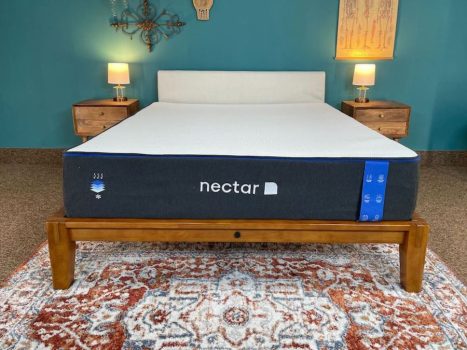
Nectar offers the deeper hug of a traditional memory foam bed but with updated cooling and a Forever warranty.
Material
Foam
Trial Period
365 nights
Shipping Method
Free shipping
Firmness
Medium-firm: 6.5/10
Warranty
Lifetime warranty
Price Range
$$$$$
We recommend this mattress for the following sleeper types:
Joint Pain
This bed is perfect for anyone suffering from joint pain.Hip Pain
This bed is perfect for anyone suffering from hip pain.Back Sleeping
Ideal for lightweight and average weight back sleepers.Side Sleeping
Ideal for lightweight and average weight side sleepers.Financing Options
Financing options are available for this mattress.
Nectar Mattress

Nectar offers the deeper hug of a traditional memory foam bed but with updated cooling and a Forever warranty.
Material
Foam
Warranty
Lifetime warranty
Firmness
Medium-firm: 6.5/10
Shipping Method
Free shipping
Trial Period
365 nights
Price Range
$$$$$
We recommend this mattress for the following sleeper types:
Joint Pain
This bed is perfect for anyone suffering from joint pain.Hip Pain
This bed is perfect for anyone suffering from hip pain.Back Sleeping
Ideal for lightweight and average weight back sleepers.Side Sleeping
Ideal for lightweight and average weight side sleepers.Financing Options
Financing options are available for this mattress.

Nectar Mattress
Nectar offers the deeper hug of a traditional memory foam bed but with updated cooling and a Forever warranty.
Material
Foam
Firmness
Medium-firm: 6.5/10
Trial Period
365 nights
Warranty
Lifetime warranty
Shipping Method
Free shipping
Price Range
$$$$$
We recommend this mattress for the following sleeper types:
Joint Pain
This bed is perfect for anyone suffering from joint pain.Hip Pain
This bed is perfect for anyone suffering from hip pain.Back Sleeping
Ideal for lightweight and average weight back sleepers.Side Sleeping
Ideal for lightweight and average weight side sleepers.Financing Options
Financing options are available for this mattress.
Why the Nectar Earned Best Mattress for Athletes with Shoulder Pain
If you play tennis, baseball, or any sport with a lot of shoulder involvement, you’re probably no stranger to joint pain. You’ll want a mattress that can cradle these sensitive body parts without sacrificing a stable, supportive base.
The Nectar is an all-foam bed that welcomes you with a hug-like plushness and sink. However, its base layer is strong and dense. While testing this bed, my fellow Lead Product Tester Julia remarked on how its three layers work together symbiotically, providing soothing pressure relief up top and bracing spinal alignment from below.
What’s the Nectar Made Of?
The Nectar is 12 inches tall and has three primary foam layers, plus a top and bottom cover.
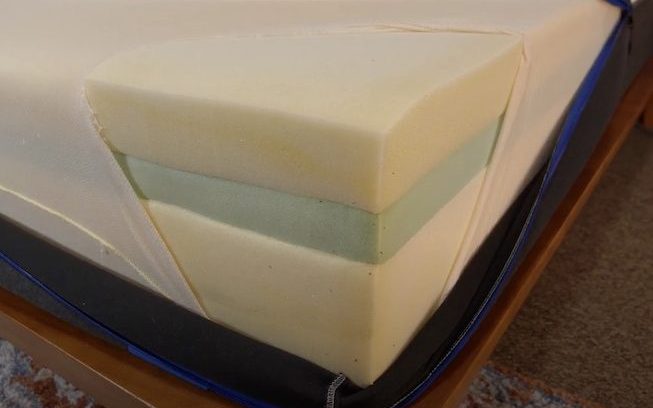
- Layer 1 – Top Cover. Heat-absorbing fibers help to keep the surface of the Nectar cool.
- Layer 2 – Gel Memory Foam (2 inches). Memory foam contours to your curves and surrounds your joints with softness.
- Layer 3 – Dynamic Response Foam (3 inches). A bouncier, firmer foam than the memory foam above.
- Layer 4 – ActiveSupport Foam (7 inches). The strong foundation of the bed. It encourages spinal alignment and gives the mattress its medium-firm feel.
- Layer 5 – Lower Cover. A polyester cover that holds the layers in.
My Take: The Nectar is often our mattress of choice for people who enjoy the signature sink of memory foam. It’s affordable, intuitively designed, and great at cradling sore spots. Side sleepers in particular tend to enjoy how it cushions their shoulders and hips.
What I Liked
- An ideal balance for back and side sleepers – The Nectar’s combination of pressure relief and support suits back and side sleepers well. In these sleeping positions, your spine should retain its natural curvature even as your joints are gently cradled.
- Outstanding price and policies – Nectar mattresses are protected by a lifetime warranty, and you’ll be able to try it out for a full year before a return costs you anything. The order itself shouldn’t hurt your wallet as much as other mattresses might—Nectars are often on sale for less than $1,000 for a queen.
Potential Drawbacks
- Not very cool – The Nectar’s cooling abilities pale in comparison to some of its competitors. All-foam beds simply can’t regulate temperature as much as hybrid beds or those with advanced cooling materials in their constructions.
- Not for heavy people or stomach sleepers – There’s a limit to the Nectar’s support system, and people who weigh more than 250 pounds won’t feel sufficiently elevated. I also wouldn’t recommend this bed to stomach sleepers, whose hips will likely sink too much to preserve proper spinal alignment.
Customer Reviews of the Nectar
With thousands of reviews on Nectar’s website, the Nectar mattress has an average 4.8 out of 5 stars. One common customer complaint about the Nectar mattress is its longer-than-average break-in period, while many customers praise its excellent value and comfort once fully settled.
Need more info? Check out our in-depth Nectar mattress review or the best mattresses for shoulder pain.
Bear Elite Hybrid – Best Mattress for Weightlifters
Bear Elite Hybrid Mattress
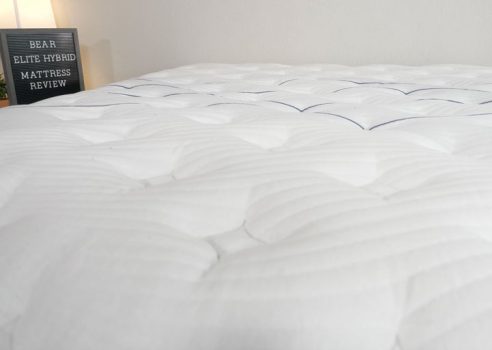
With coils and foam layers, this Bear mattress offers zoned support without taking away from the pressure-relieving properties. The bed also has copper infusions to ensure the best cooling for hot sleepers and athletes.
Material
Hybrid
Trial Period
120 nights
Shipping Method
Free shipping
Firmness
Medium-firm: 6/10
Warranty
Lifetime Warranty
Price Range
$$$$$
We recommend this mattress for the following sleeper types:
Hot Sleepers
If you often overheat while you sleep, this mattress should help you stay cool.Back Sleeping
Ideal for lightweight, average weight, and heavyweight back sleepers.Stomach Sleeping
Ideal for lightweight and average weight stomach sleepers.Financing Options
Financing options are available for this mattress.
Bear Elite Hybrid Mattress

With coils and foam layers, this Bear mattress offers zoned support without taking away from the pressure-relieving properties. The bed also has copper infusions to ensure the best cooling for hot sleepers and athletes.
Material
Hybrid
Warranty
Lifetime Warranty
Firmness
Medium-firm: 6/10
Shipping Method
Free shipping
Trial Period
120 nights
Price Range
$$$$$
We recommend this mattress for the following sleeper types:
Hot Sleepers
If you often overheat while you sleep, this mattress should help you stay cool.Back Sleeping
Ideal for lightweight, average weight, and heavyweight back sleepers.Stomach Sleeping
Ideal for lightweight and average weight stomach sleepers.Financing Options
Financing options are available for this mattress.

Bear Elite Hybrid Mattress
With coils and foam layers, this Bear mattress offers zoned support without taking away from the pressure-relieving properties. The bed also has copper infusions to ensure the best cooling for hot sleepers and athletes.
Material
Hybrid
Firmness
Medium-firm: 6/10
Trial Period
120 nights
Warranty
Lifetime Warranty
Shipping Method
Free shipping
Price Range
$$$$$
We recommend this mattress for the following sleeper types:
Hot Sleepers
If you often overheat while you sleep, this mattress should help you stay cool.Back Sleeping
Ideal for lightweight, average weight, and heavyweight back sleepers.Stomach Sleeping
Ideal for lightweight and average weight stomach sleepers.Financing Options
Financing options are available for this mattress.
Why the Bear Elite Hybrid Earned Best Mattress for Weightlifters
Weightlifters need a mattress that will readily support lots of muscle mass as well as facilitate muscle recovery. And, because not every weightlifter has the same body type or comfort preferences, a bed with multiple available firmnesses could be beneficial.
“I think competitive weightlifters are going to want something supportive after heavy lifting sessions, to help keep joints supported overnight,” said former Olympian and competitive weightlifter Caine Wilkes. “Since Olympic weightlifting and powerlifting are weight-class sports, though, I think smaller athletes would probably prefer a medium firmness instead.”
Fortunately, the Bear Elite Hybrid allows for choice. It’s the most luxurious mattress made by a brand that already markets to athletes (lifters included). You can pick between a Firm, Medium, or Soft version of the hybrid, but no matter what, you’ll get a cover with two key ingredients: phase change material for cooling, and Celliant® for muscle recovery. By transforming body heat into infrared energy, Celliant® allegedly cuts down on inflammation and helps to oxygenate the body’s tissues.
“It’s a real step up from the already-awesome Bear [Star] Hybrid,” said Stuart, one of our regular testers. He especially appreciated the Elite Hybrid’s evident cooling and zoned support.
What’s the Bear Elite Hybrid Made Of?
The Bear Elite Hybrid is 14 inches high and has five total layers. You can order it in Firm, Medium, or Soft, depending on your preferences.
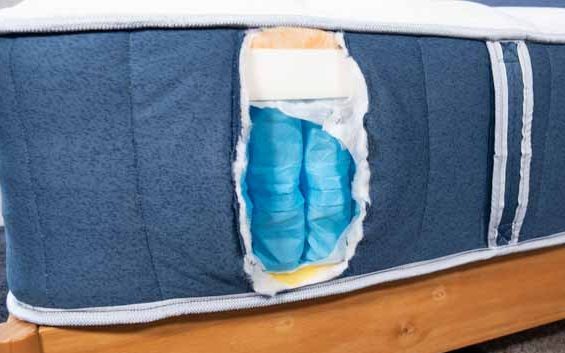
- Layer 1 – Cover. The bed’s cover is made with phase change material (PCM) that absorbs and releases excess heat. It also incorporates Celliant®, a performance textile that may boost your body’s ability to recover after a tough workout.
- Layer 2 – Copper-Infused Memory Foam. A pressure-relieving foam that boasts the cooling and antimicrobial properties of copper.
- Layer 3 – Dynamic Transition Foam. A firmer foam layer that shields you from feeling the innersprings below.
- Layer 4 – Coils. Individually wrapped springs with a reinforced lumbar zone so your lower back feels bolstered. The coils along the perimeter of the bed are also stronger for enhanced edge support.
- Layer 5 – High-Density Support Foam. A sturdy base.
Our Take: “One of the things that I really like about the Bear is that they understand people who try and live active lifestyles … [They use] copper-infused memory foam that responds to your body and cools accordingly.” – Stuart Petty, Sleep Advisor Mattress Tester
What We Liked
- Cools down like a champ – As if the Celliant® factor wasn’t enticing enough to weightlifters who want to feel well-rested, the phase change material that’s also in the cover seems to be extremely proficient at cooling. “Bear knows that sleeping cool helps you have a restorative night’s sleep,” Stuart commented. “The cooling was immediately noticeable as I lied down on the bed.” In fact, we gave this mattress a perfect 5 out of 5 in the cooling category.
- Zoned springs also help with recovery – “Sleepers with back, hip, or shoulder pain will love the zoned coil system. It’s built to relieve pressure in the areas you sleep on and support the areas that need a little extra boost, specifically the lumbar area,” said Stuart.
Potential Drawbacks
- Might be too cold for some – Another tester, Sydney, found the Bear Elite Hybrid to be a little too good at keeping things cool. She’s not prone to overheating at night, and so would need some extra blankets to get cozy in this model.
- Cost may be a roadblock – This is one of the “fancier” beds on the market today, and when sales aren’t active, it costs about $2,300 for a queen. I’d say that’s a fair price for all those features, but luckily, you can often snag the Bear Elite at a discount.
Customer Reviews of the Bear Elite Hybrid
According to Bear’s website, the Bear Elite Hybrid scores about 4.5 out of 5 stars. Some customers find the Bear Elite Hybrid mattress too firm for their liking, but it receives praise in its reviews for its advanced cooling technology and pressure relief.
Want to learn more? Read our full Bear Elite Hybrid mattress review.
DreamCloud – Best Mattress for Runners
DreamCloud Original Mattress
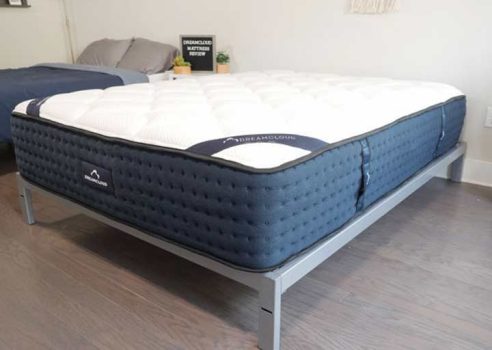
Luxurious hybrid at a great price with a lifetime warranty.
Material
Hybrid
Trial Period
365 nights
Shipping Method
Free shipping
Firmness
Medium-firm: 6.5/10
Warranty
Lifetime warranty
Price Range
$$$$$
We recommend this mattress for the following sleeper types:
Hot Sleepers
If you often overheat while you sleep, this mattress should help you stay cool.Seniors
This bed is perfect for senior sleepers.Back Sleeping
Ideal for average weight back sleepers.Financing Options
Financing options are available for this mattress.
DreamCloud Original Mattress

Luxurious hybrid at a great price with a lifetime warranty.
Material
Hybrid
Warranty
Lifetime warranty
Firmness
Medium-firm: 6.5/10
Shipping Method
Free shipping
Trial Period
365 nights
Price Range
$$$$$
We recommend this mattress for the following sleeper types:
Hot Sleepers
If you often overheat while you sleep, this mattress should help you stay cool.Seniors
This bed is perfect for senior sleepers.Back Sleeping
Ideal for average weight back sleepers.Financing Options
Financing options are available for this mattress.

DreamCloud Original Mattress
Luxurious hybrid at a great price with a lifetime warranty.
Material
Hybrid
Firmness
Medium-firm: 6.5/10
Trial Period
365 nights
Warranty
Lifetime warranty
Shipping Method
Free shipping
Price Range
$$$$$
We recommend this mattress for the following sleeper types:
Hot Sleepers
If you often overheat while you sleep, this mattress should help you stay cool.Seniors
This bed is perfect for senior sleepers.Back Sleeping
Ideal for average weight back sleepers.Financing Options
Financing options are available for this mattress.
Why the DreamCloud Earned Best Mattress for Runners
Runners place a lot of stress on their lower bodies. Your hips, legs, and feet can all experience soreness after a long run (and injuries to these areas can occur if you overtax yourself). A new mattress probably won’t shrink your average mile time, but it can ensure that you’re well-rested before your next race or practice.
“Without good sleep, especially as I have gotten older, the practice’s quality diminishes,” said Andrew Cusmano, a runner and Bowerman Track Club Elite Athlete. “I practice primarily from 6:45 AM on, so there is no opportunity to nap or anything middle of the day to catch up if I missed sleep the night before.”
When it comes to mattress shopping as a runner, support for your spine, hips, and legs should be paramount. Cusmano looks for firm mattresses that won’t cause back pain due to lack of support, and have enough length to keep his feet and legs elevated. Given his feedback, I recommend the DreamCloud for runners: it’s a medium-firm hybrid mattress with lots of spine-aligning lift.
Julia, my fellow lead product tester, is a stomach sleeper who needs to feel a reassuring boost beneath her hips as she sleeps. This mattress is one of her “all-time favorites,” because it has enough sturdy support “to keep you from sinking into weird angles and enter the danger zone of back pain.”
What’s the DreamCloud Made Of?
The DreamCloud is 12 inches tall and has eight total layers if you count its top and lower covers.
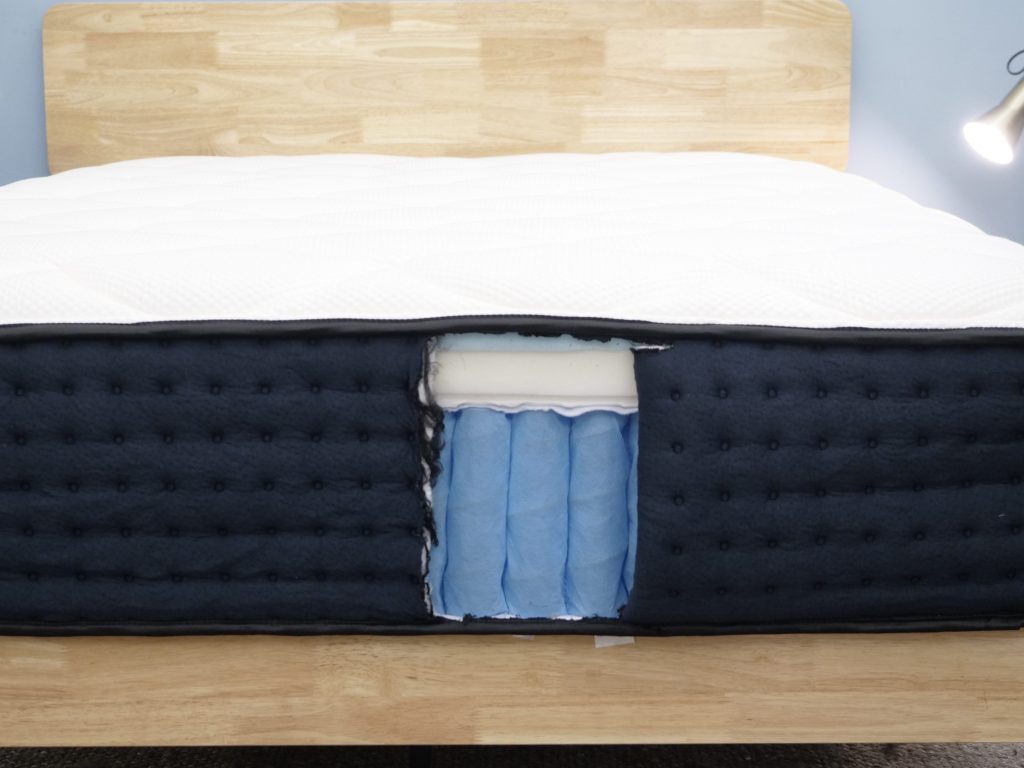
- Layer 1 – Cashmere Blend Cover. A cover made of a luxurious and comfortable cashmere blend.
- Layer 2 – Contouring Quilted Foam. A foam layer quilted into the bed’s cover for initial softness.
- Layer 3 – Supportive Quilted Foam. This foam is also quilted into the cover and is slightly firmer than the layer above it.
- Layer 4 – Gel-Infused Memory Foam. A pressure-relieving layer that molds to the shape of your body.
- Layer 5 – Dynamic Transition Layer. This layer shields you from feeling any of the innersprings beneath and also encourages your spine to rest in its natural curvature.
- Layer 6 – Coils. Steel coils that support the full expanse of the mattress, including reinforced edges.
- Layer 7 – Base Layer. A thick foundation of standard foam.
- Layer 8 – Lower Cover. The bottom cover prevents slippage and sports handles for easy transport.
Our Take: “No matter what sleep position I chose—side, stomach, back—I felt supported in each one.” – Julia Forbes, Lead Product Tester
What We Liked
- An affordable option – The DreamCloud won’t break the bank, even with all those classy layers. When discounts are active, it can retail for under $1,000 for a queen. “Honestly, for how well rounded this bed is, I’m surprised it doesn’t cost more,” Julia remarked.
- Isolates motion better than you’d think – “The materials all do a pretty good job of absorbing the feeling of motion and responding quickly to movement on the top of the bed,” Julia said. We gave the DreamCloud a 4 out of 5 for motion isolation, which is a better score than we expected considering how much bounce and support you can feel from its springs.
Potential Drawbacks
- Weaker edges – If you’re someone who tends to sleep or sit on the edges of your mattress, the DreamCloud may not be a good fit. We experienced a lot of buckling at the sides when we applied pressure during testing.
- Not the best contouring – This bed doesn’t have the traditional “hugging” memory foam feel—it will definitely keep you on top of its surface rather than cradled within its layers. Look elsewhere if you want to really sink into your mattress.
Customer Reviews of the DreamCloud
The DreamCloud Original scores a solid 4.6 out of 5 stars among customers on its site. While some customers appreciate the value and affordability of the DreamCloud Original mattress, others find it to be on the heavier side, which could make moving or rotating the mattress more challenging.
Looking for more info? Read our full DreamCloud review.
WinkBed Plus – Best Mattress for Plus-Size Athletes
WinkBed Plus Mattress
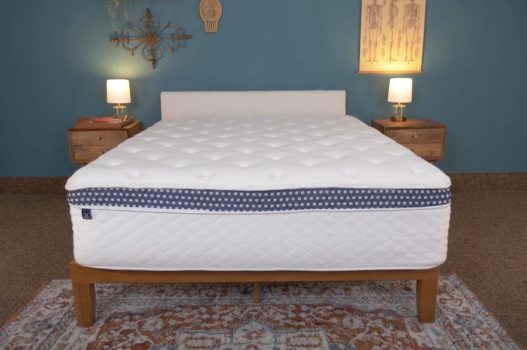
WinkBed’s quality design and support make the Plus an exceptional option for heavier folks.
Material
Hybrid
Trial Period
120 nights
Shipping Method
Free shipping
Firmness
Medium-firm: 6.5/10
Warranty
Lifetime warranty
Price Range
$$$$$
We recommend this mattress for the following sleeper types:
Hot Sleepers
If you often overheat while you sleep, this mattress should help you stay cool.Back Sleeping
Ideal for heavyweight back sleepers.Stomach Sleeping
Ideal for heavyweight stomach sleepers.Financing Options
Financing options are available for this mattress.
WinkBed Plus Mattress

WinkBed’s quality design and support make the Plus an exceptional option for heavier folks.
Material
Hybrid
Warranty
Lifetime warranty
Firmness
Medium-firm: 6.5/10
Shipping Method
Free shipping
Trial Period
120 nights
Price Range
$$$$$
We recommend this mattress for the following sleeper types:
Hot Sleepers
If you often overheat while you sleep, this mattress should help you stay cool.Back Sleeping
Ideal for heavyweight back sleepers.Stomach Sleeping
Ideal for heavyweight stomach sleepers.Financing Options
Financing options are available for this mattress.

WinkBed Plus Mattress
WinkBed’s quality design and support make the Plus an exceptional option for heavier folks.
Material
Hybrid
Firmness
Medium-firm: 6.5/10
Trial Period
120 nights
Warranty
Lifetime warranty
Shipping Method
Free shipping
Price Range
$$$$$
We recommend this mattress for the following sleeper types:
Hot Sleepers
If you often overheat while you sleep, this mattress should help you stay cool.Back Sleeping
Ideal for heavyweight back sleepers.Stomach Sleeping
Ideal for heavyweight stomach sleepers.Financing Options
Financing options are available for this mattress.
Why the WinkBed Plus Earned Best Mattress for Plus-Size Athletes
Plus-size and heavyweight athletes need a bed that will reliably support them without sagging or developing lasting body impressions. The WinkBed Plus was made for sleepers who weigh more than 250 pounds, and is one of the first mattresses designed specifically for larger bodies.
“If you’re over 250 pounds, I highly recommend checking out this model,” said Sean, one of our plus-sized reviewers. “It’s just a great mattress for anyone who likes a firmer feel with a pressure-relieving pillow top.” Athletes should also enjoy its multiple cooling elements, strong edges, and zoned coils.
What’s the WinkBed Plus Made Of?
The WinkBed Plus is 13.5 inches tall. Unlike the traditional WinkBed model, it incorporates latex foam into its design,
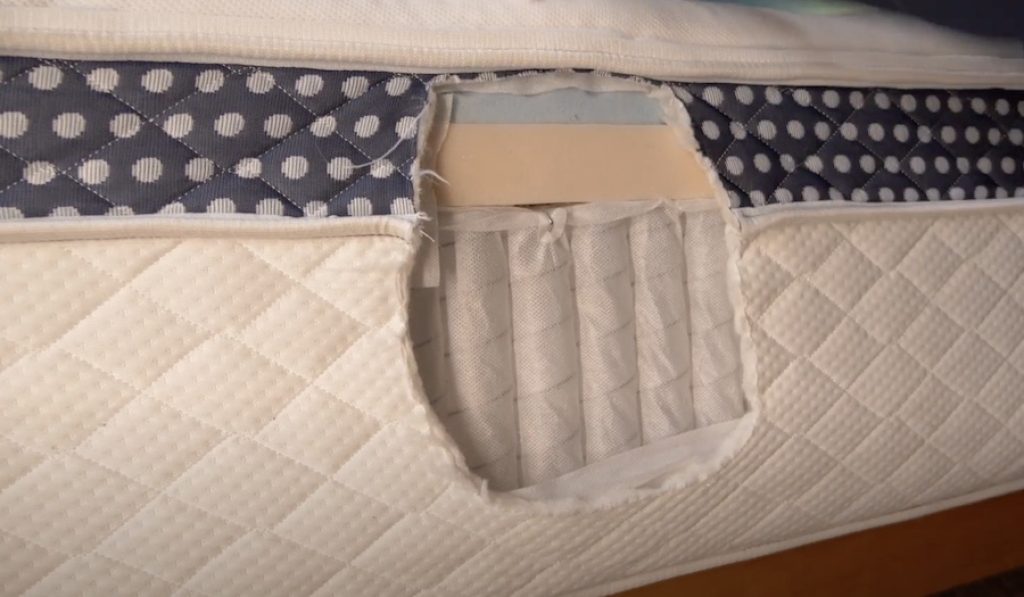
- Tencel™ Cover – A breathable, wood-derived cover that feels pleasantly soft.
- High-Density Anti-Sag Foam – WinkBeds claims that this foam is more than 50% denser than traditional comfort layers, and shouldn’t sag after long-term use.
- Latex Support Layer – A 2.5-inch layer of springy latex that’s divided into seven support zones. These zones lend a precise amount of support to the body parts underneath them, and the latex itself runs naturally cooler than synthetic foams.
- Coil Unit – Individually wrapped coils designed to support more weight than traditional innerspring units. They’re also reinforced along the bed’s edges.
Our Take: “The WinkBed Plus is a mattress specifically designed for larger individuals, and will most likely be too firm for individuals below 120 pounds … I found the bed to give me an excellent amount of support, while other features of the bed such as the cooling factor added to the overall comfort of it.” – Sean, Sleep Advisor Mattress Tester
What I Liked
- Supportive and responsive – Sean enjoyed how buoyed he felt by the WinkBed Plus’s innerspring system, and, as a combo sleeper, he was grateful for the latex layer, too. “Its latex is more responsive and bouncy to help with repositioning to keep you from feeling stuck,” he noted.
- Isolates motion well – For such a bouncy mattress, the WinkBed Plus didn’t trip our motion-transfer measurements too much. “Those of you who have partners that move around a lot at night shouldn’t have to worry about being disturbed,” Sean said.
Potential Drawbacks
- Not meant for lighter folks – Emma, a relatively lightweight sleeper, didn’t feel like the WinkBed Plus was the right fit for her. She rested just on top of the bed, and “didn’t get to take advantage of all those wonderful transition layers.” Sean also commented that this mattress “will most likely be too firm for individuals below 120 pounds.”
- It’s tough to move – “The WinkBed Plus is significantly thicker than most beds sold online,” Sean said. Once you unpackage it from its box and set it up, transporting it to another location will require some helping hands.
Customer Reviews of the WinkBed Plus
With a score of 4.8 out of 5 stars the WinkBed Plus is a hit with sleepers seeking a firm and supportive mattress. Customers appreciate the WinkBed Plus mattress for its exceptional support for heavier individuals, but some have mentioned that it may be too firm for those seeking a softer sleep surface.
Interested in more details? Read our complete WinkBed Plus review, or scope out the best beds for heavy people.
Nolah Evolution – Best Cooling Mattress for Athletes
Nolah Evolution Hybrid Mattress
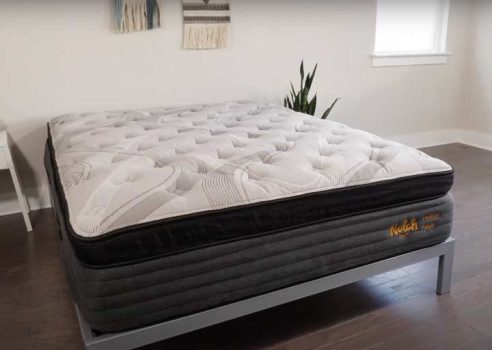
Nolah’s innovative pressure-relieving abilities should be an excellent fit for side-sleepers, and if you struggle with overheating, the AirFoamICE™ technology should keep you cool all night long.
Material
Hybrid
Trial Period
120 nights
Shipping Method
Free shipping
Firmness
Multiple firmness options
Warranty
Lifetime warranty
Price Range
$$$$$
Nolah Evolution Hybrid Mattress

Nolah’s innovative pressure-relieving abilities should be an excellent fit for side-sleepers, and if you struggle with overheating, the AirFoamICE™ technology should keep you cool all night long.
Material
Hybrid
Warranty
Lifetime warranty
Firmness
Multiple firmness options
Shipping Method
Free shipping
Trial Period
120 nights
Price Range
$$$$$

Nolah Evolution Hybrid Mattress
Nolah’s innovative pressure-relieving abilities should be an excellent fit for side-sleepers, and if you struggle with overheating, the AirFoamICE™ technology should keep you cool all night long.
Material
Hybrid
Firmness
Multiple firmness options
Trial Period
120 nights
Warranty
Lifetime warranty
Shipping Method
Free shipping
Price Range
$$$$$
Why the Nolah Evolution Earned Best Cooling Mattress for Athletes
If you’re an athlete who spends a lot of time sweating, you’d probably prefer to stay cool and dry in bed. Unfortunately, feeling overheated at night is a common problem, and it can drastically reduce the quality of your sleep.
To combat it, you might consider the Nolah Evolution. This hybrid mattress stands an imperial 15 inches high, and many of those inches are dedicated to cooling components. It even has a specialized gusset that surrounds the top 4 inches of the bed and vents out excess heat.
Julia timed how quickly the bed could cool off after she had rested on it for five minutes, and it only took two minutes to regain its starting temperature (a refreshing 68 degrees). This efficiency earned it a perfect 5 out of 5 from us in the cooling category.
What’s the Nolah Evolution Made Of?
The Nolah Evolution has seven total layers if you count its top cover, and stands 15 inches high. You can order it in Plush, Luxury Firm, or Firm.
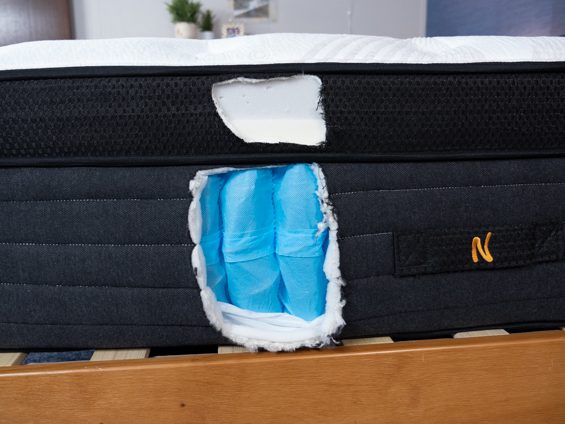
- Layer 1 – Top Cover. Made of organic cotton and ArcticTex™ cooling fibers, the cover creates a refreshingly soft and chill sleep surface.
- Layer 2 – Euro Topper (2 inches). The plush topper features breathable foam and quilting with high thermal conductivity, which should help redirect unwanted warmth.
- Layer 3 – AirFoamICE™ (2 inches). Nolah’s proprietary alternative to memory foam is infused with cooling graphite and full of tiny air bubbles. According to the brand, it relieves pressure and resists heat much better than traditional foams.
- Layer 4 – High-Resilience Foam (2 inches). A firmer foam that girds the foams above it.
- Layer 5 – High-Density Transition Foam (1 inch). A responsive foam that separates the comfort layers from the coil unit.
- Layer 6 – Coils (8 inches). Zoned, individually wrapped springs that up their support beneath the lumbar region. They’re also strengthened around the sides of the bed for edge support.
- Layer 7 – Recycled Plant Fiber Foundation. A durable base layer.
Our Take: ““The Nolah Evolution has been one of my favorite mattresses to try. Not only is it supportive, but it’s really comfortable. I really love the relief I get from the pressure in my hips.” – Liz, Sleep Advisor Mattress Tester
What We Liked
- Choose your firmness – The Nolah Evolution is available in three firmness levels, so you can pick the one that sounds most appealing for your nightly recovery. We tested the Luxury Firm version and thought it was right in the medium-firm zone, at 6.5 out of 10 on our scale.
- Amazing edges – “I really love the care Nolah has taken to reinforce the edges,” Liz remarked. “As someone with disabilities, getting in and out of bed can be a little difficult. But having the reinforced edges makes all the difference.”
Potential Drawbacks
- A tall bed can make shopping a bit harder – Because this mattress is 15 inches tall, you’ll need to look for fitted sheets with deep pockets—some sizes may not wrap all the way around the corners.
- Not firm enough for stomach sleepers – Julia’s a stomach sleeper, and she wouldn’t recommend the Nolah Evolution to others who prefer this position. The initial plushness of the bed may cause their hips to dip too low.
Customer Reviews of the Nolah Evolution
The Nolah Evolution rates 4.5 stars out of 5 on Nolah’s website. Customers frequently commend the Nolah Evolution mattress for its exceptional pressure relief and cooling properties, but some have observed that it may produce slight off-gassing upon unboxing.
Need more info? Check out our in-depth Nolah Evolution mattress review or browse the best mattresses for hot sleepers.
Brooklyn Bedding Spartan – Best Mattress for Muscle Recovery
Brooklyn Bedding Spartan Hybrid Mattress
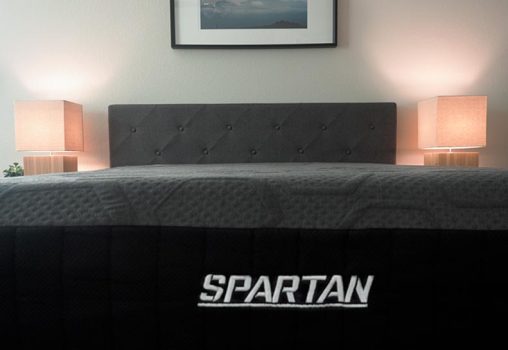
The Spartan Hybrid features the brand’s Nanobionic RE-3™ technology to help you renew energy and rest better. The bed combines foam and coils, so it’s bouncy but supportive enough to prevent you from sinking in.
Material
Hybrid
Trial Period
120 nights
Shipping Method
Free shipping
Firmness
Multiple firmness options
Warranty
10-year warranty
Price Range
$$$$$
We recommend this mattress for the following sleeper types:
Joint Pain
This bed is perfect for anyone suffering from joint pain.Back Pain
This bed is perfect for anyone suffering from back pain.Side Sleeping
Ideal for lightweight and average weight side sleepers.Financing Options
Financing options are available for this mattress.
Brooklyn Bedding Spartan Hybrid Mattress

The Spartan Hybrid features the brand’s Nanobionic RE-3™ technology to help you renew energy and rest better. The bed combines foam and coils, so it’s bouncy but supportive enough to prevent you from sinking in.
Material
Hybrid
Warranty
10-year warranty
Firmness
Multiple firmness options
Shipping Method
Free shipping
Trial Period
120 nights
Price Range
$$$$$
We recommend this mattress for the following sleeper types:
Joint Pain
This bed is perfect for anyone suffering from joint pain.Back Pain
This bed is perfect for anyone suffering from back pain.Side Sleeping
Ideal for lightweight and average weight side sleepers.Financing Options
Financing options are available for this mattress.

Brooklyn Bedding Spartan Hybrid Mattress
The Spartan Hybrid features the brand’s Nanobionic RE-3™ technology to help you renew energy and rest better. The bed combines foam and coils, so it’s bouncy but supportive enough to prevent you from sinking in.
Material
Hybrid
Firmness
Multiple firmness options
Trial Period
120 nights
Warranty
10-year warranty
Shipping Method
Free shipping
Price Range
$$$$$
We recommend this mattress for the following sleeper types:
Joint Pain
This bed is perfect for anyone suffering from joint pain.Back Pain
This bed is perfect for anyone suffering from back pain.Side Sleeping
Ideal for lightweight and average weight side sleepers.Financing Options
Financing options are available for this mattress.
Why the Brooklyn Bedding Spartan Earned Best Mattress for Muscle Recovery
Athletes looking to give their hardworking muscles a restorative rest may need more from their mattress than the standard foams and fabrics. Luckily, the Brooklyn Bedding Spartan has a trick up its sleeve—or more precisely, in its cover.
The cover’s fibers boast far infrared ray (FIR) technology. According to the brand, this technology can shift your body heat into infrared energy, which in turn boosts blood flow and aids muscle recovery as you sleep. To complement this feature, the foam just below the cover is infused with a phase change material, which helps to cool you off if you’re running warm.
What’s the Brooklyn Bedding Spartan Made Of?
The Brooklyn Bedding Spartan is 11.5 inches tall and contains six key layers. The thickness of the foam layers changes depending on which firmness you order: Soft, Medium, or Firm.
- Cover – Inside the high-tech cover, fibers convey far infrared rays (FIR) that may enhance your post-workout recovery.
- CopperFlex™ Foam – A cooling foam infused with phase change material for temperature regulation, as well as antimicrobial copper.
- Supreme Response Comfort Foam (1.5 inches) – A responsive, springy foam with firmness that corresponds to the model you ordered (Soft, Medium, or Firm).
- Gel Swirl Memory Foam (Soft/Medium Models) or VariFlex™ Transition Foam (Firm Model) – This transitional layer separates the comfort foams above from the springs below.
- Zoned Coils – Individually wrapped coils split into three zones, with reinforced edges. Each zone is meant to give the corresponding region of your body the appropriate amount of support.
- Base Foam – A strong foam foundation.
Our Take: We dig the Brooklyn Bedding brand for their reasonably priced yet technologically advanced and durable beds. This is one of their most specialized models, and we’d recommend it to any athlete who’s picky about their firmness level and wants to truly pamper their muscles.
What We Liked
- Marketed to athletes specifically – Not many beds target athletes as their primary users, but the Spartan was built for them. The brand touts its “active recovery” capabilities as its main selling point.
- Not as pricey as comparable beds – The Brooklyn Bedding Spartan costs around $2,000 for a queen, but that price often dips to around $1,500 when sales are running. Given the state-of-the-art materials inside this bed, we think that’s a stellar deal.
Potential Drawbacks
- Motion isolation could be better – The 8-inch coil unit takes up a lot of space in this bed, and you’ll probably feel a co-sleeper’s movements.
- Won’t cradle you like an all-foam model – This is a hybrid bed through-and-through, so it likely won’t satisfy any cravings for a plush, slow-sinking sleep surface.
Customer Reviews of the Brooklyn Bedding Spartan
The Spartan scores a 4.8 out of 5 stars among reviewers on the Brooklyn Bedding site. Customers appreciate the Brooklyn Bedding Spartan mattress for its advanced cooling features, but some have noted that its price may be on the higher side for budget-conscious shoppers.
Interested in more details? See our complete Brooklyn Bedding Spartan mattress review.
Saatva Classic – Best Mattress for Athletes with Back Pain
Saatva Mattress
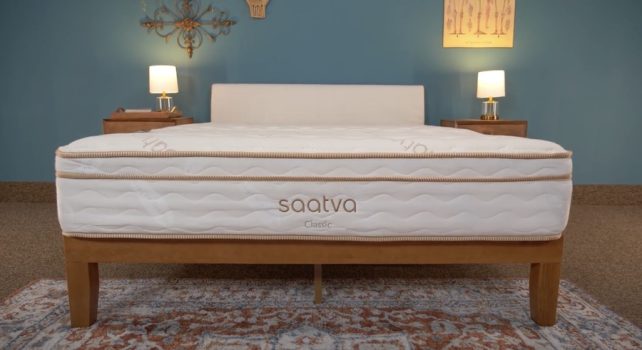
Coil-on-coil structure gives this elevated innerspring bed a luxurious feel and versatility.
Material
Innerspring
Trial Period
365 nights
Shipping Method
Free white glove delivery
Firmness
Multiple firmness options
Warranty
Lifetime warranty
Price Range
$$$$$
We recommend this mattress for the following sleeper types:
Hot Sleepers
If you often overheat while you sleep, this mattress should help you stay cool.Back Pain
This bed is perfect for anyone suffering from back pain.Back Sleeping
Ideal for lightweight, average weight, and heavyweight back sleepers.Stomach Sleeping
Ideal for lightweight and average weight stomach sleepers.Financing Options
Financing options are available for this mattress.
Saatva Mattress

Coil-on-coil structure gives this elevated innerspring bed a luxurious feel and versatility.
Material
Innerspring
Warranty
Lifetime warranty
Firmness
Multiple firmness options
Shipping Method
Free white glove delivery
Trial Period
365 nights
Price Range
$$$$$
We recommend this mattress for the following sleeper types:
Hot Sleepers
If you often overheat while you sleep, this mattress should help you stay cool.Back Pain
This bed is perfect for anyone suffering from back pain.Back Sleeping
Ideal for lightweight, average weight, and heavyweight back sleepers.Stomach Sleeping
Ideal for lightweight and average weight stomach sleepers.Financing Options
Financing options are available for this mattress.

Saatva Mattress
Coil-on-coil structure gives this elevated innerspring bed a luxurious feel and versatility.
Material
Innerspring
Firmness
Multiple firmness options
Trial Period
365 nights
Warranty
Lifetime warranty
Shipping Method
Free white glove delivery
Price Range
$$$$$
We recommend this mattress for the following sleeper types:
Hot Sleepers
If you often overheat while you sleep, this mattress should help you stay cool.Back Pain
This bed is perfect for anyone suffering from back pain.Back Sleeping
Ideal for lightweight, average weight, and heavyweight back sleepers.Stomach Sleeping
Ideal for lightweight and average weight stomach sleepers.Financing Options
Financing options are available for this mattress.
Why the Saatva Classic Earned Best Mattress for Athletes with Back Pain
Whether it’s from twisting, lifting, or getting tackled, back pain is a common and aggravating problem for athletes and active folks. If your mattress doesn’t have enough active support to fill the gap between your lower back and the bed, this pain can be even more severe. Enter the Saatva Classic: a bed with two innerspring systems that leads the pack in lumbar support.
Julia, our lead reviewer, said that her midsection felt “perfectly lifted” by the Saatva Classic while she was on her back and stomach. Stuart, one of our mattress testers who has experienced back pain in his own life, was likewise impressed. “I [have] to shout out the tons of lumbar support,” he said. “You’ll always have lots of support for your lower back.”
What’s the Saatva Classic Made Of?
The Saatva Classic is available in two heights (11.5 or 14.5 inches) and three firmness levels (Plush Soft, Luxury Firm, and Firm).
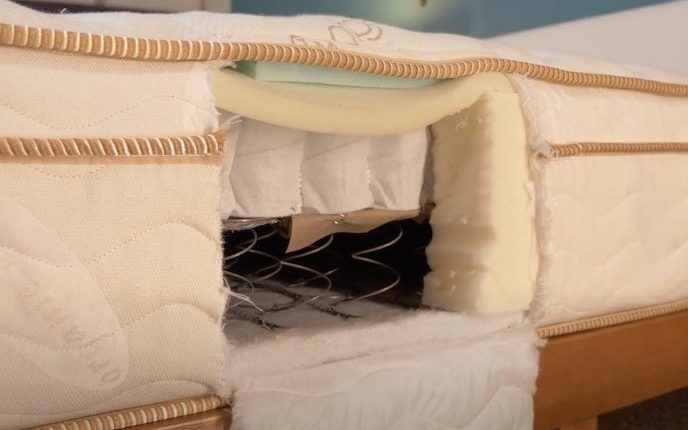
- Euro Top – An organic cotton cover protects the 3-inch Euro top, which has been quilted in the middle third to feel firmer under your lumbar spine.
- Memory Foam Lumbar Crown – A strip of memory foam positioned just under the lower back for a combination of pressure relief and lift.
- Pocketed Coils – The first coil unit consists of individually wrapped “comfort coils,” which flex easily to match the shape of your body. They’re strengthened under the lower back for more lumbar support.
- Lumbar Zone® Active Spinal Wire – A wire within the innerspring units that further braces the lumbar region and encourages proper spinal alignment.
- Interconnected Coils – A more traditional innerspring unit that adds to the bed’s longevity and support.
- High-Density Foam Rails – Thick foam rails along the bed’s perimeter keep the edges sturdy.
Our Take: “It’s pretty on par with a hotel mattress. You have a cushy Euro pillow top to sink into, along with extra lumbar support foam and two types of coils for full body support.” – Julia, Lead Product Tester
What We Liked
- Built to your specs – Two height options and three firmness options mean you can truly customize this bed to fit your preferences. “Because this mattress is so flexible, all sleep positions and body types can find what they need here. It really is a one-stop shop,” Julia remarked.
- Eco-friendly – Saatva uses a variety of sustainable and natural materials in their beds, including a plant-based flame retardant in place of a synthetic one. Their springs are made of recycled steel, the cotton in their covers is organic, and even their protective antimicrobial treatments are described as “botanical” and “biodegradable.”
Potential Drawbacks
- No impressive cooling materials – The Classic feels cool enough, thanks to the airflow around its coils and breathable cotton cover, but it doesn’t showcase any dedicated cooling materials.
- Motion travels easily – Two spring units translates to a lot of bounce and a fair amount of motion transfer. If you’re easily woken up by a partner getting in and out of bed, you may want to invest in a different model. “You can definitely feel big movements,” Julia warned.
Customer Reviews of the Saatva Classic
The Saatva Classic rates 4.8 stars out of 5 on Saatva’s website. One negative aspect customers found with the Saatva Classic mattress is that it may feel too firm for some users, while a notable advantage is its high-quality materials, providing durability and support.
Need more info? Check out our in-depth Saatva mattress review or explore the best mattresses for back pain.
Bear Original – Best Firm Mattress for Athletes
Bear Original Mattress
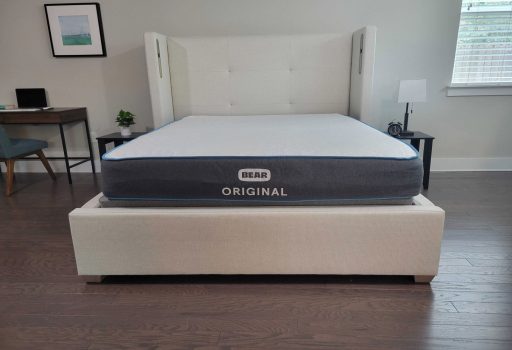
This flagship model was thoughtfully crafted and assembled to be an attractive all-foam option for athletes who need better rest.
Material
Foam
Trial Period
120 nights
Shipping Method
Free shipping
Firmness
Medium-firm: 6.5/10
Warranty
Lifetime warranty
Price Range
$$$$$
We recommend this mattress for the following sleeper types:
Hot Sleepers
If you often overheat while you sleep, this mattress should help you stay cool.Back Sleeping
Ideal for lightweight and average weight back sleepers.Side Sleeping
Ideal for lightweight and average weight side sleepers.Financing Options
Financing options are available for this mattress.
Bear Original Mattress

This flagship model was thoughtfully crafted and assembled to be an attractive all-foam option for athletes who need better rest.
Material
Foam
Warranty
Lifetime warranty
Firmness
Medium-firm: 6.5/10
Shipping Method
Free shipping
Trial Period
120 nights
Price Range
$$$$$
We recommend this mattress for the following sleeper types:
Hot Sleepers
If you often overheat while you sleep, this mattress should help you stay cool.Back Sleeping
Ideal for lightweight and average weight back sleepers.Side Sleeping
Ideal for lightweight and average weight side sleepers.Financing Options
Financing options are available for this mattress.

Bear Original Mattress
This flagship model was thoughtfully crafted and assembled to be an attractive all-foam option for athletes who need better rest.
Material
Foam
Firmness
Medium-firm: 6.5/10
Trial Period
120 nights
Warranty
Lifetime warranty
Shipping Method
Free shipping
Price Range
$$$$$
We recommend this mattress for the following sleeper types:
Hot Sleepers
If you often overheat while you sleep, this mattress should help you stay cool.Back Sleeping
Ideal for lightweight and average weight back sleepers.Side Sleeping
Ideal for lightweight and average weight side sleepers.Financing Options
Financing options are available for this mattress.
Why the Bear Original Earned Best Firm Mattress for Athletes
A firm mattress puts support first, sacrificing plushness for more pronounced spinal alignment and lift. If you’re an athlete who doesn’t mind a less-than-pillowy bed, then you may benefit from a firm model like the Bear Original—it should keep your back and hips from dipping too low and exacerbating any pain or soreness.
Perhaps surprisingly, this bed is entirely made of foam. But as Stuart said after testing it out, “it’s a little firmer than the typical all-foam mattress, which should make it a little bit more versatile for different kinds of sleepers.”
What’s the Bear Original Made Of?
The Bear Original is 10 inches tall and has four main layers.
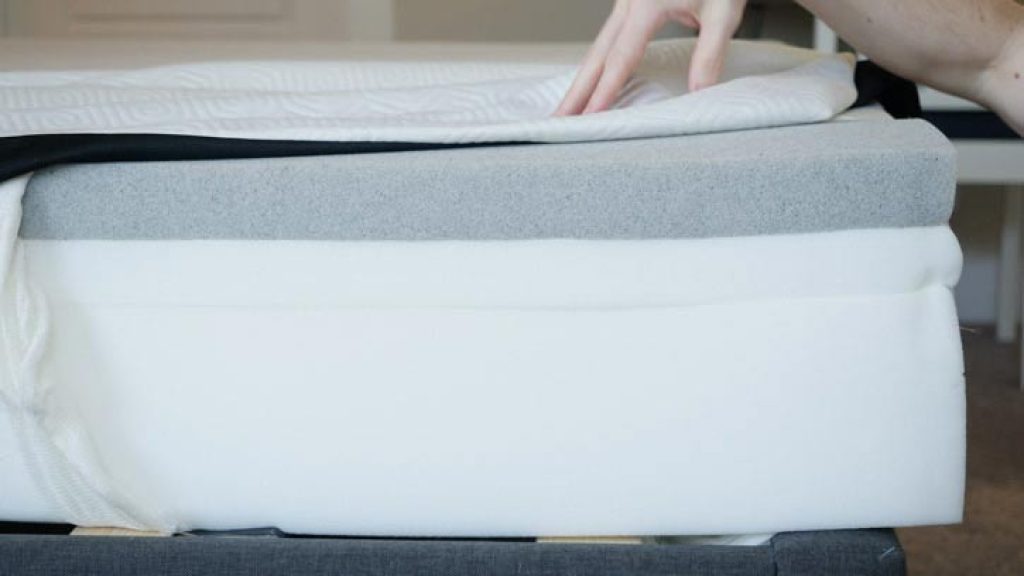
- Layer 1 – Tencel™ Cover. A breathable cover made of Tencel™, a fabric derived from wood pulp.
- Layer 2 – Cooling Gel Memory Foam. Foam that relieves pressure by conforming to your body, infused with gel to help it resist heat.
- Layer 3 – Bear Dynamic Foam. A more supportive and responsive foam than the memory foam above for a balanced feel.
- Layer 4 – High-Density Support Foam. A strong foam foundation.
Our Take: “For the average-sized sleeper, this is going to feel like a firm bed. Naturally, a heavier sleeper would experience this bed as softer. [And] it’s a great option for couples, it’s not likely you’ll disturb one another’s sleep.” – Stuart, Sleep Advisor Mattress Tester
What We Liked
- Foam absorbs motion – The Bear Original will isolate motion far better than a hybrid bed. Stuart was impressed by how well it cancelled out bounces and shakes: “I’m pretty sure you could do a cannonball into this bed and your partner would be none the wiser.”
- Option to add Celliant® – This bed doesn’t come with a Celliant® cover, but you can add one at checkout for a fee. Bear claims that this performance textile can enhance your nightly muscle recovery as well as the quality of your sleep.
Potential Drawbacks
- Too firm for side sleeping – Both Stuart and his fellow tester Mark thought that the Bear Original might be a touch too hard for side sleepers. “When I was laying on my side, it was maybe just a little bit too firm. I was comfortable, but I do think I would have a hard time sleeping on it overnight,” Mark said.
- Lower profile – At 10 inches tall, this is one of the thinnest beds in our lineup. Some people prefer a low-profile mattress, but heavy people may not derive enough support from this one.
Customer Reviews of the Bear Original
On Bear’s website, the Bear Original has more than 10,000 reviews and an average rating of 4.3 out of 5 stars. Customers appreciate the Bear Original mattress for its cooling features, yet some express concerns about a potential initial off-gassing odor.
Need more info? Check out our in-depth Bear Original mattress review or our list of the best firm mattresses.
How to Choose the Best Mattress for Athletic Performance: Key Considerations
As an athlete, you’ll want a mattress that helps you recuperate and feel refreshed for your next game, workout, race, or movement of choice. Look through the considerations below as you search for your next bed, and read on to learn how to get quality sleep that can boost your athletic performance.
Your Sport or Athletic Goals
The demands on your body will depend your preferred sport or form of exercise, and your mattress should pair well with your goals. For example, if you’re trying to bulk up and lift heavier, you’ll want a bed with a high weight capacity; if you’re focusing on your hips and legs as you train for a marathon, you’ll want plenty of lumbar support.
If you have a trainer, they’ll be a wonderful resource as you set goals for yourself and map them onto your mattress. Decide what’s most important to you as you hone your skills, and then look for beds that seem to address these priorities.
Special Textiles for Muscle Recovery
A few mattresses on our roundup above have special fibers in their construction that allegedly promote muscle recovery, such as Celliant®. These textiles claim to convert body heat into infrared energy, which can increase blood flow, decrease inflammation, and generally help your body to recuperate after a workout.
The hard science on these technologies is lacking, as the studies on their efficacy are few and have small sample sizes. But some athletes say that they make a difference, and we encourage you to try these beds to see for yourself if the performance textiles work for you.
Sports Injuries
If you play a high-impact sport, or if any of your athletic pursuits leave you open to injuries (acute or chronic), you’ll want a mattress that doesn’t make things worse.
Look at beds that have enough pressure relief, as athletes’ joints are particularly vulnerable. In fact, in a study[4] published in 2022, one in four former Olympic athletes was later diagnosed with osteoarthritis.
It’s not just elite, professional athletes who experience joint pain, either; athletes of all ages can experience joint pain and injury, particularly those who play high-impact sports[5] or do high-impact workouts.
This is where a mattress with good pressure relief can come in. Pressure-relieving materials such as memory foam and latex foam will gently cradle the joints and other sensitive zones of the body, reducing tension and potentially offsetting pain in those areas.
The height of the bed might also make a difference, as it’s easier to get in and out of taller beds than shorter ones (especially if your mobility is compromised).
Finally, you may want to look into adjustable bed frames. These allow you to raise your head and feet into a variety of postures, and can be useful for elevating injured limbs.
Read More: Best Mattresses for Pressure Relief
Your Weight and Body Type
Depending on your sport, your body weight may have a bearing on your athletic performance, and might even be used as a metric for sorting you into a certain competitive class. For some athletes, such as football players, basketball players, and weightlifters, being larger or taller can have its advantages.
Your weight also affects your perception of your mattress’s firmness level. The “average” body type feels just peachy on a good medium-firm mattress. (That’s any bed that falls between a 5 and a 7 on our firmness scale). However, heavier athletes may need more support in the form of a firm mattress, and lightweight ones will feel better atop a plush mattress.
Additionally, heavyweight athletes may need stronger support materials, such as springs, whereas average- and lightweight folks may feel supported enough on an all-foam bed. (If you’re a larger athlete in need of a bed that will support you without sagging, check out our list of the best beds for heavy people.)
No matter what you weigh, you’ll want your spine to feel neutral and well-aligned when you lay down. If you feel like parts of your body are too elevated or too sunken, and that your weight is being distributed unevenly, you should look for a different bed.
Cooling Elements
A good cool-down isn’t just an essential phase of your workout—it’s also important for getting restful sleep. Research[1] indicates that many elite and sub-elite athletes attribute poor sleep quality to feeling too hot while in bed.
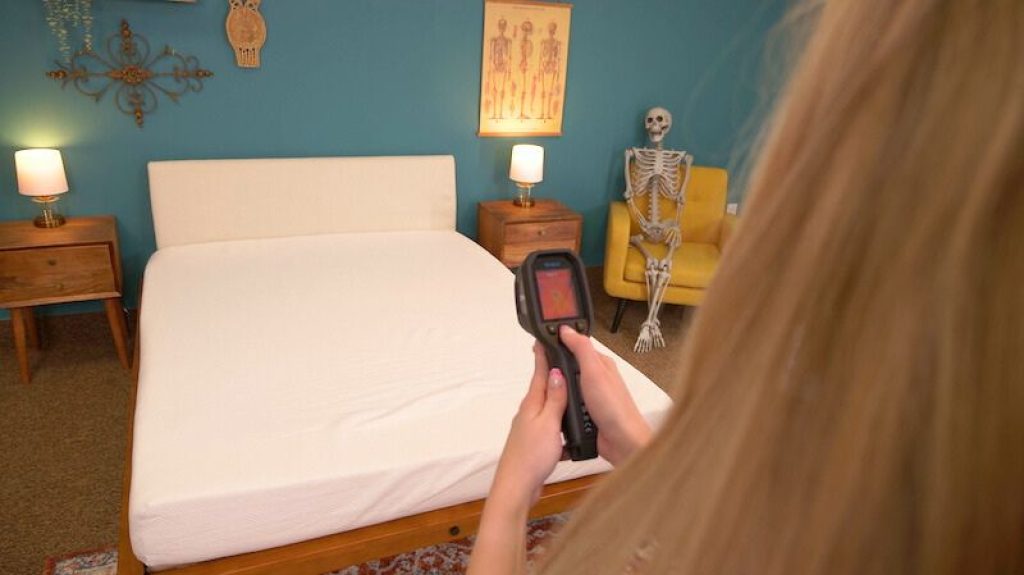
Staying at a comfortable temperature at night is easier when your mattress has effective cooling elements. Keep an eye out for phase change material—a fancy term for a substance that absorbs and releases heat as the molecules inside it shift between solid and liquid—and other heat-dissipating or breathable fabrics, such as cotton or Tencel™.
Mattress type also plays a role in cooling. Typically, memory foam mattresses are going to retain the most heat, whereas a bed with latex and/or springs will allow for cooling airflow.
Mattress Type
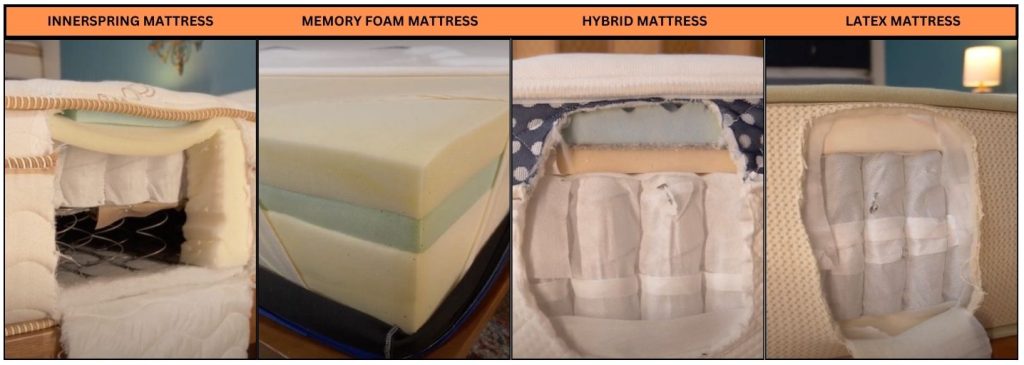
Innerspring Mattresses
Innerspring mattresses have a thin comfort layer on top of a primary layer of steel innerspring coils. They feel bouncy and supportive, but they don’t have a lot of cushion.
Innerspring beds tend to sleep cooler than beds that include memory foam, which can be a plus for athletes who work up a sweat during the day. They’re also reliable when it comes to preserving healthy spinal alignment.
On the other hand, they don’t offer much pressure relief for sore muscles and joints, because they lack the thicker comfort foams of other mattress types.
See our picks for the best innerspring mattresses.
Hybrid Mattresses
Hybrid mattresses include a layer of innerspring coils as well as several comfort layers on top. They combine the benefits of traditional innerspring mattresses and all-foam mattresses, so they can both support the spine and relieve pressure on the joints. This combination makes them a great pick for athletes of any stripe.
“I train all year long for both football and wrestling and have found that a hybrid mattress is the optimal mattress type for me. It provides everything I need to rest and recover from training and hard-hitting games and matches,” said 16-year-old athlete Henry Russell.
Browse the best hybrid mattresses.
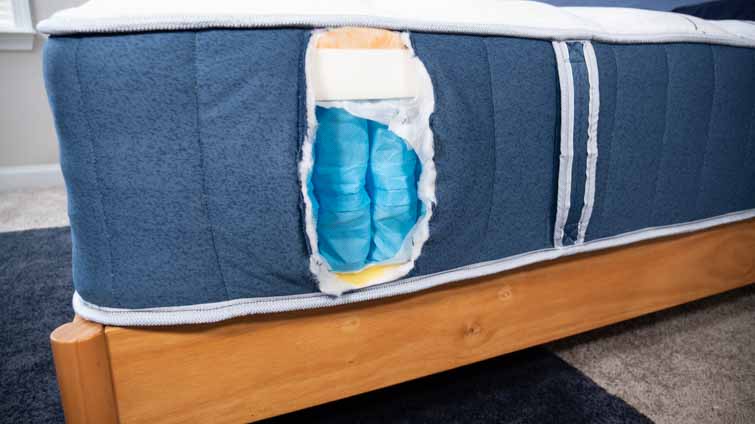
Memory Foam Mattresses
When you lie down on a memory foam mattress, you can expect to sink into the bed to some degree. You might feel a “deep hug” from the foam, or more of a gentle cradling sensation. For athletes with joint pain or certain injuries, memory foam can help reduce soreness and pressure buildup.
However, memory foam tends to trap heat. It can also feel less supportive for athletes who weigh more than 230 pounds or so. If that’s you, but you’re still set on a mattress with memory foam in its construction, we’d recommend a hybrid that contains memory foam in its comfort layers.
See our recommendations for the top memory foam mattresses.
Latex Mattresses
Natural latex foam is made from the sap of rubber trees. It’s a breathable, cool, and bouncy material with more eco-friendly credentials than synthetic foams. It’s also quite durable, and should last you for several years—a big benefit if you’re an athlete who wants a long-lasting bed that won’t sag.
Although it provides a nice balance of support and pressure relief, it doesn’t have the same “sinking” feel of memory foam, and some people don’t like its springiness. It’s also one of the priciest mattress materials on the market today.
Read through our list of the best latex mattresses.
Your Sleeping Position
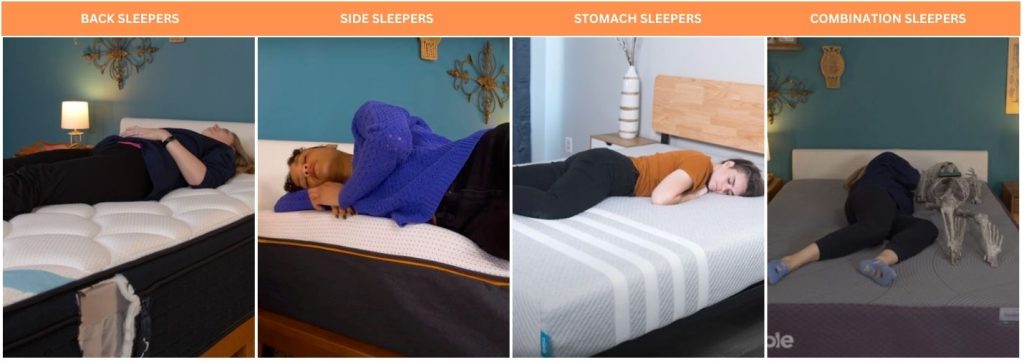
If you consistently sleep on your side, you’ll want a mattress that feels softer and relieves pressure around your shoulders and hips. If your mattress is too unyielding, it’ll create tension in these “sharper” areas – a big problem for athletes.
If you sleep mostly on your back, you’ll want a bed that isn’t too soft and isn’t too firm. A medium-firm bed helps the spine to stay in neutral alignment through the night, staving off lower back pain.
If you sleep on your stomach, your mattress will need to be pretty firm. A firmer, more supportive construction keeps the hips from dipping so low that your spine falls out of its ideal alignment.
Budget
Deciding how much to spend on a new mattress can be a fraught process. But if you’re an athlete, a quality bed is extremely important—your investment in your sleep can be directly reflected in your energy levels and performance during the day.
While ultra-budget beds can be very cheap upfront, they often aren’t as durable or well-made, so don’t just go for the lowest price you find. Typically, innerspring mattresses and all-foam beds are less expensive, whereas hybrids and latex mattresses cost more.
Additionally, some eco-friendly models may run higher in price as they incorporate more natural and organic materials.
If you shop during key holidays or when deals are active, you can often save hundreds of dollars on your new bed. Shopping online also allows you to access high-end mattresses at lower prices than you’d see in stores, because they’re sold directly from the manufacturer.
Anything Else that Helps You Achieve Restful Sleep
We’ve covered some of the key considerations for athletes in need of a new mattress, but you’re the true expert on your sleep and comfort needs. There are many more aspects that can make a mattress feel awesome—or awful.
For example, if you’re a light sleeper, you’ll want a bed that isolates motion well; and if you spread out a lot during the night, then edge support will be an important factor.
Finally, some mattress features will benefit any sport or exercise. Always look for a bed that encourages your spine to rest in its natural, neutral curvature, with no uncomfortable or uneven spots. Regardless of whether you’re an athlete or not, good spinal alignment is important for preventing back pain[11].
Advice from a Medical Expert
We also reached out to Dr. Raj Dasgupta, who has over 20 years of experience in the medical field, to see his thoughts on what key qualities athletes need in a mattress.
“Athletes need a mattress that supports their body, relieves pressure, stays cool, lasts long, minimizes motion transfer, and feels right in terms of personal firmness preferences to help them recover and perform their best.”
How Can a Mattress Help with Athletic Performance?
A mattress that works well for your body will enhance the quality of your sleep, which in turn helps with your recovery after exercise, your athletic performance the next day, and your overall health. “Sleep is very important to me as a strength athlete, mostly because it’s the simplest and easiest way to help recover from daily training, and it probably helps the most, too,” said Caine Wilkes.
When we sleep, we go through two sleep phases: Non-REM and REM sleep. During Non-REM sleep[10], your body builds bone and muscle, repairs tissues, and strengthens your immune system. Therefore, a good mattress can up your sleep quality and your body’s ability to recuperate.
Athletes in particular stand to gain a lot from improving their sleep hygiene. Increasing the time you spend sleeping has been shown to have a positive effect on multiple athletic skills, from the accuracy of a tennis serve or basketball free throw to the efficiency of kicks while swimming.
On the other hand, sleep deprivation can drastically hinder your physical and mental performance. It affects your reaction time, endurance, and many other faculties essential to athleticism.[9]
What Causes Sleep Problems in Athletes?
It’s common for athletes to experience more disturbed sleep – especially elite or professional athletes[1]. At the same time, though, athletes actually need more sleep than an average person for a multiple reasons[6], including muscle recovery, carbohydrate metabolism, appetite, food intake, protein synthesis, and even the kind of fast, reflexive thinking that enables you to catch a quick pass.
Some of the external factors[7] that can cause sleep problems in athletes include competition schedules, travel, stress, academic demands (in student athletes), and overtraining.
Overtraining[8] is a prevalent cause of insomnia and trouble sleeping in athletes. In fact, insomnia is considered one of the first signs that you might be overtraining. If that’s the case, be sure you’re taking at least one to two rest days per week, and eating enough calories to support the training you’re doing.
Doing an intense workout one hour before bed has also been shown to decrease sleep quality[2], so we recommend completing your big training sessions during the day.
Learn more: Sleep and Exercise – How Timing These Two Can Improve Your Health
Sleep Apnea in Athletes
Multiple athletes and celebrities, including Shaquille O’Neal, have spoken about their experience with sleep apnea. This condition can become dangerous if left untreated, as it disrupts your breathing during sleep. It can also negatively affect your athletic performance.
“A few years ago I took a sleep test, found out I had sleep apnea, and have been using an APAP ever since,” said Caine Wilkes. APAP stands for Automatic Positive Airway Pressure device, a machine that helps to keep your airway open during sleep.
Once he began using an APAP at night, Wilkes got more and better sleep, the benefits of which extended to his weightlifting. “While my lifts didn’t suddenly jump up 10 kilograms or anything like that, I did notice an immediate difference in that I could stay focused during my training sessions and came just a bit more energized.”
How To Get Better Sleep as an Athlete
Make Sleep a Part of Your Athletic Practice
- Develop a regular sleep schedule – Going to bed and waking up at the same time each night and morning can do wonders for your body and energy levels. If you’re an athlete, sleep is especially vital to your recovery, so we recommend trying to nail down a sleep routine.
- Get outside as early as you can – While we’re on the subject of sleep schedules, you should know that exposing yourself to morning sunlight when you start your day is a simple hack for resetting your circadian rhythm. A morning walk is a great way to get sunlight exposure while staying active.
- Take a rest day – Research shows that overtraining, especially without compensating with enough calories, is linked to insomnia[8]. Experts recommend[16] that you rest a minimum of one day per seven to 10 days, though many athletes who engage in high-intensity exercise will need more.
Wind Down Before Bed
- Make your room like a cave – Keep your bedroom dark, quiet, and cool, much like a cave. This is the best environment to get a good night’s sleep. If you live in a noisy area, a white noise machine could help tamp down auditory distractions.
- Don’t work out one hour before bed – Research from Harvard Health tells us that high-intensity exercise just before bed can negatively impact sleep quality.[2] Move your training to earlier in the day, and do some gentle stretching at night instead.
- Take magnesium before bed – Magnesium is touted as “nature’s calming agent” for its ability to reduce anxiety and insomnia in many people. Luckily for athletes, research shows it’s also great for muscle recovery[17]. We’ve compiled some of the best magnesium supplements for sleep to help you integrate it into your nightly routine.
Adjust Your Diet to Improve Your Sleep
- Eat more complex carbs – Favor complex carbs (like whole grains or sweet potatoes) over simple carbs (like bread or pasta). Complex carbs raise serotonin levels and lower cortisol levels, which can help you sleep[14].
- Make sure you’re getting enough calories – Athletes need more calories than the average person because they’re burning more calories on a day-to-day basis. If you’re training too strenuously without keeping pace with your food intake, you may also start sweating a lot at night due to low blood sugar.[3] It’s recommended that competitive athletes eat anywhere from 3,000 to 5,000 calories[15] per day.
- Reduce your intake of caffeine and alcohol – Studies show that consuming caffeine up to six hours[18] before bedtime can negatively impact your sleep. Likewise, consuming alcohol can not only negatively impact your sleep quality[19], but it can also inhibit your athletic performance[20].
Try Additional Recovery Techniques
- Practice meditation before bed – If you’re experiencing anxiety or stress, falling asleep is often difficult. Meditating before bed is one way to calm your mind in preparation for better sleep.
- Treat your muscles to a cold plunge – Many athletes swear by the positive effects of cold plunges on their recovery and performance. A dip in body temperature near bedtime can also prime you for sleep, so these watery therapies are doing double duty. Read up on the best cold plunge tubs if you’re curious about adding one to your home.
- Sit in a sauna – A session in a home sauna can relax your muscles as well as your mind. These heated spaces have myriad potential benefits, from easing soreness to facilitating sleep, though the extent of their effects is still being studied.
Best Mattress for Athletes FAQs
What type of mattress is best for athletes?
A hybrid mattress often represents the best ratio of pressure relief to support for athletes.
In general, an athlete’s mattress should be supportive for the spine, pressure-relieving on the joints, and pleasantly cool. Finding a mattress with zoned support can also be beneficial, as it provides specialized degrees of resistance to different parts of the body (such as the low back).
What mattresses do pro athletes use?
Professional athletes often use custom-designed mattresses that have been built to suit their bodies. They may also use a certain mattress brand that’s partnered with their sports organization. Sleep Number, for example, is an official partner of the NFL, and many pro football players use Sleep Number beds in their homes.
Otherwise, just like the general public, pro athletes can use their own discretion when shopping for a mattress—though they probably have a larger budget than most!
Are firm mattresses better for athletes?
A firm mattress will definitely be better for an athlete than a very soft one, which could lead to uneven support and poor spinal alignment.
However, comfort should always be a factor in selecting your mattress, so we suggest aiming for a good balance of supportive firmness and pressure-relieving cushion. Hybrid mattresses often have softer foams at the surface paired with a strong innerspring unit at the base, and this combination works well for many athletes.
What’s the best sleeping position for athletes?
Back sleeping is recommended as the best sleeping position for athletes (and for most people), especially if you have any shoulder, hip, back, or joint issues.12
In this position, your spine should be straight and well-supported, and your pillow should be just low enough to keep the natural curvature of your spine – just as it would be when standing up straight. Back sleeping can also allow your hip flexors and core to straighten and relax, which are often trouble areas for runners and lifters.
The only real downside to back sleeping is it can increase snoring and sleep apnea. If you deal with either of these, side sleeping is a good second choice for athletes.
We don’t recommend stomach sleeping if you can help it. It can create tension and pain in the neck and back, which certainly won’t help your athletic performance.
What mattress doesn’t make you sweat?
Mattresses that contain coils and advanced cooling foams will sleep the coolest and help to prevent sweating the most. Latex foam and breathable covers can also regulate temperature.
That being said, it’s always good to read reviews before buying to see how effective a certain mattress is at cooling.
Final Breakdown: The Best Beds for Athletes
| Mattress | Best For | Price (Queen Size) | Review |
| Helix Midnight Luxe | Editor’s Pick | $2,049 | Helix Midnight Luxe Mattress Review |
| Nectar | Athletes with Shoulder Pain | $999 | Nectar Mattress Review |
| Bear Elite Hybrid | Weightlifters | $2,305 | Bear Elite Hybrid Mattress Review |
| DreamCloud | Runners | $1,332 | DreamCloud Mattress Review |
| WinkBed Plus | Plus-Size Athletes | $1,999 | WinkBed Plus Mattress Review |
| Nolah Evolution | Cooling | $2,299 | Nolah Evolution Mattress Review |
| Brooklyn Bedding Spartan | Muscle Recovery | $1,999 | Spartan Mattress Review |
| Saatva Classic | Athletes with Back Pain | $1,995 | Saatva Classic Mattress Review |
| Bear Original | Firm | $998 | Bear Original Mattress Review |

Loren Bullock
Lead Product Tester
About Author
Loren is the Lead Reviewer at Sleep Advisor. She has prioritized sleeping for as long as she can remember, rarely deviating from seven to nine hours each night.
Combination Sleeper
References:
- Doherty, Ronan., et al. “The Sleep and Recovery Practices of Athletes”. National Library of Medicine. 2021.
- “Does exercising at night affect sleep?”. Harvard Health Publishing. 2019.
- “Hypoglycemia (Low Blood Sugar) in People Without Diabetes”. University of Michigan Health. Last modified April 13, 2022.
- “Quarter of former Olympians suffer from osteoarthritis”. University of Edinburgh. 2022.
- Amoako, Adea., Pujalte, George. “Osteoarthritis in young, active, and athletic individuals”. National Library of Medicine. 2014.
- Halson, Shona. “Sleep and Athletes”. Gatorade Sports Science Institute. 2017.
- Watson, Andrew. “Sleep and Athletic Performance”. National Library of Medicine. 2017.
- Lastella, Michele., et al. “Can Sleep Be Used as an Indicator of Overreaching and Overtraining in Athletes?”. National Library of Medicine. 2018.
- Vitale, Kenneth., et al. “Sleep Hygiene for Optimizing Recovery in Athletes: Review and Recommendations”. National Library of Medicine. 2019.
- “Sleep Basics”. Cleveland Clinic. Last modified December 7, 2020.
- “Improve Posture & Alignment for Your Spine”. National Spine Health Foundation. 2020.
- “The Best — and Worst — Sleep Positions for Back Pain”. Keck Medicine of USC. Last modified August 12, 2022.
- “Good Sleeping Posture Helps Your Back”. University of Rochester Medical Center. Webpage accessed June 11, 2024.
- Nisar, Maheen., et al. “Influence of Dietary Intake on Sleeping Patterns of Medical Students”. National Library of Medicine. 2019.
- “Nutrient Needs of Athletes”. OpenOregon Educational Resources. Webpage accessed May 19, 2024.
- Ansorge, Rick. “Rest and recovery are critical for an athlete’s physiological and psychological well-being”. UCHealth Today. 2022.
- Córdova, Alfredo., et al. “Impact of Magnesium Supplementation in Muscle Damage of Professional Cyclists Competing in a Stage Race”. National Library of Medicine. 2019.
- Drake, Christopher., et al. “Caffeine effects on sleep taken 0, 3, or 6 hours before going to bed”. National Library of Medicine. 2013.
- Thakkar, Mahesh M., Sharma, Rishi., Sahota, Pradeep. “Alcohol disrupts sleep homeostasis”. Alcohol. 2015.
- “Alcohol and Athletic Performance”. California State University Chico. Webpage accessed June 11, 2024.